March saw a definite improvement in the weather and club members did lots of flying. There was very little rain in the month which meant the parking area has now dried out well and our cars won’t be getting filthy every time we go flying. There was an easterly wind on several days so MVSA members were often flying and on a few occasions the paragliders and/or hang gliders appeared but they seemed to sitting around waiting a lot more than they were flying so rarely stopped our flying. As the weather warmed up the young bullocks that had wintered in the barn were let out into our field and they must have discovered what an electric fence does. One of the corner posts was down when we arrived to fly one day and they’d left us a few presents on one corner of the patch. But the fence had mostly done it’s job as they were all stood around close to, but not on, the patch and once we had herded them away they didn’t bother us again. The next day that we flew the fence was untouched and they had been moved to a different field. They will probably return sometime in the future but hopefully they will have learnt not to touch the fence.
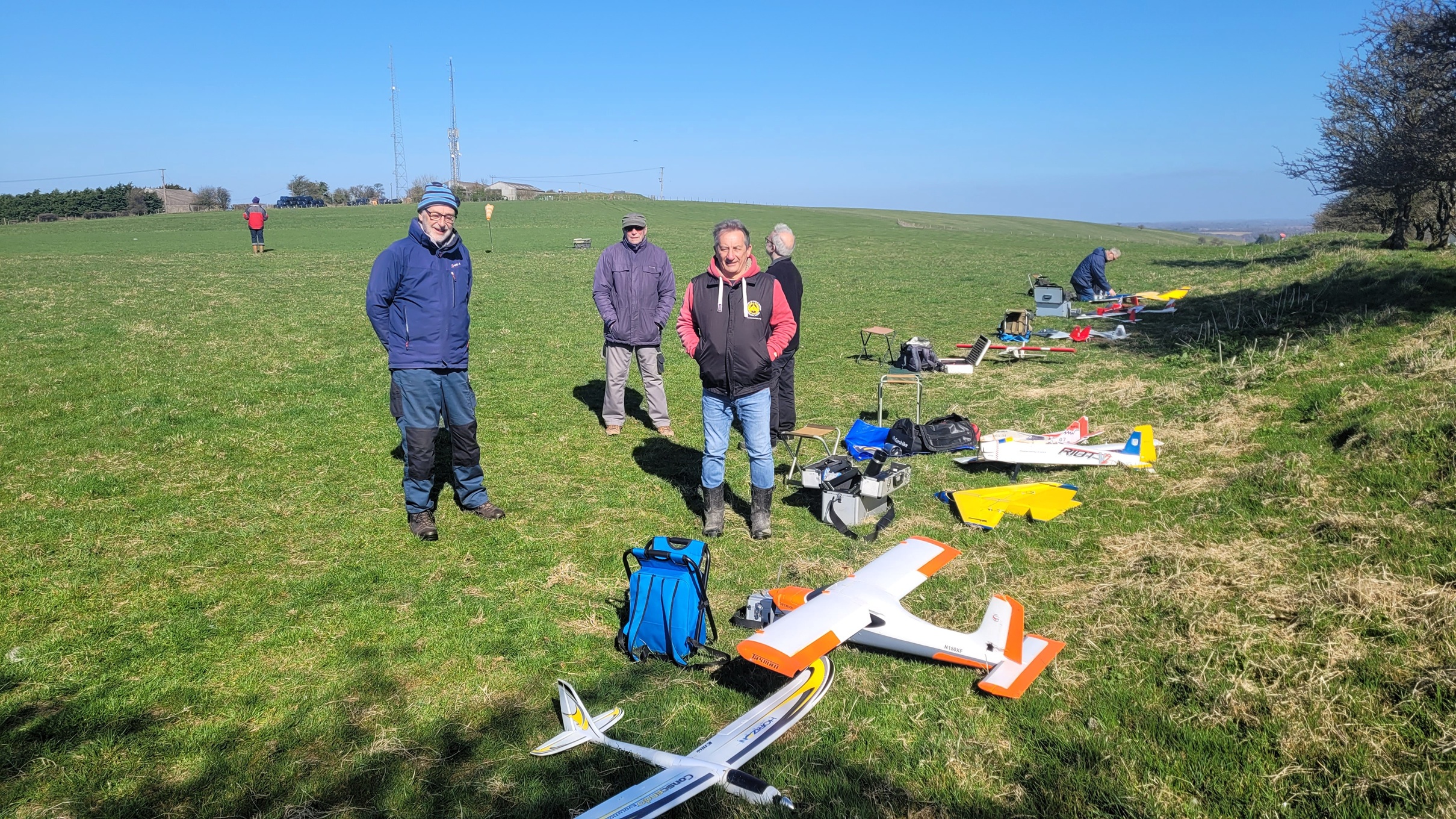 On Sunday March 30th the weather was lovely and sunny but with a very strong wind at ninety degrees to the strip so there was more standing around socialising than flying!
On Sunday March 30th the weather was lovely and sunny but with a very strong wind at ninety degrees to the strip so there was more standing around socialising than flying!
One of the newest club members, Terry Small, has been learning to fly for a few months. 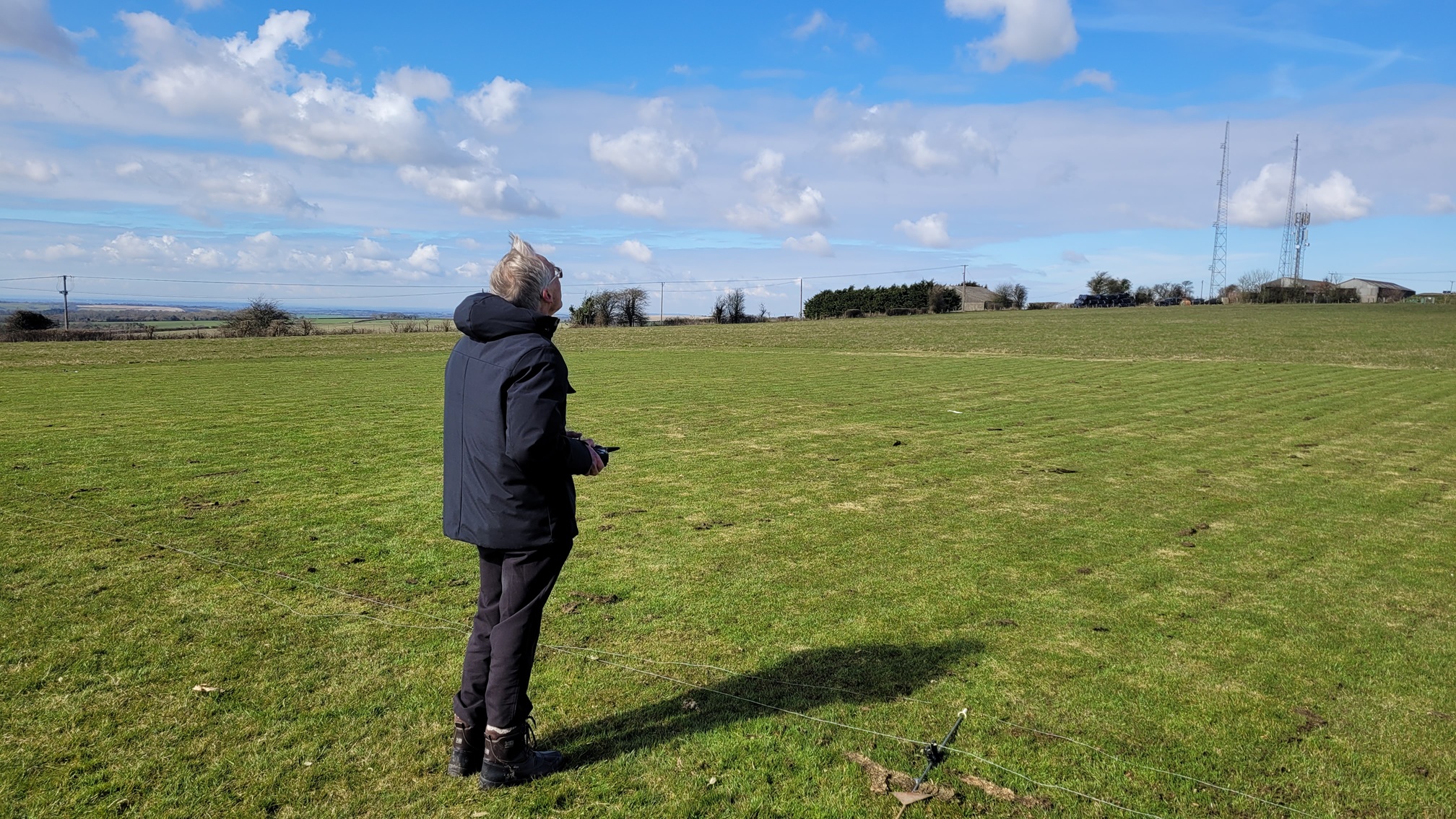 Terry came to the club having already flown a little 700mm span HobbyZone Apprentice STOL which is a scaled down version of the 1500mm span E-flite Apprentice. The little Apprentice is fully stabilised and too light to qualify for the BMFA ‘A’ certificate so Terry bought the larger E-flite version and has been working towards taking his ‘A’ test. He’s done quite a lot of practising on his simulator but complains that the wind at the field is different to the simulator wind, it’s too strong/too bumpy/wrong direction/the wrong sort of wind etc. so 1066 suggested a suitable blog name for him and Terry will now be known as Windshy! He’s had the usual few knocks along the way but nothing too drastic and by the end of March I suggested he was ready for the test. I think I know why he chose to take his test on the 26th when there was a very light wing blowing straight down the strip!
Terry came to the club having already flown a little 700mm span HobbyZone Apprentice STOL which is a scaled down version of the 1500mm span E-flite Apprentice. The little Apprentice is fully stabilised and too light to qualify for the BMFA ‘A’ certificate so Terry bought the larger E-flite version and has been working towards taking his ‘A’ test. He’s done quite a lot of practising on his simulator but complains that the wind at the field is different to the simulator wind, it’s too strong/too bumpy/wrong direction/the wrong sort of wind etc. so 1066 suggested a suitable blog name for him and Terry will now be known as Windshy! He’s had the usual few knocks along the way but nothing too drastic and by the end of March I suggested he was ready for the test. I think I know why he chose to take his test on the 26th when there was a very light wing blowing straight down the strip!
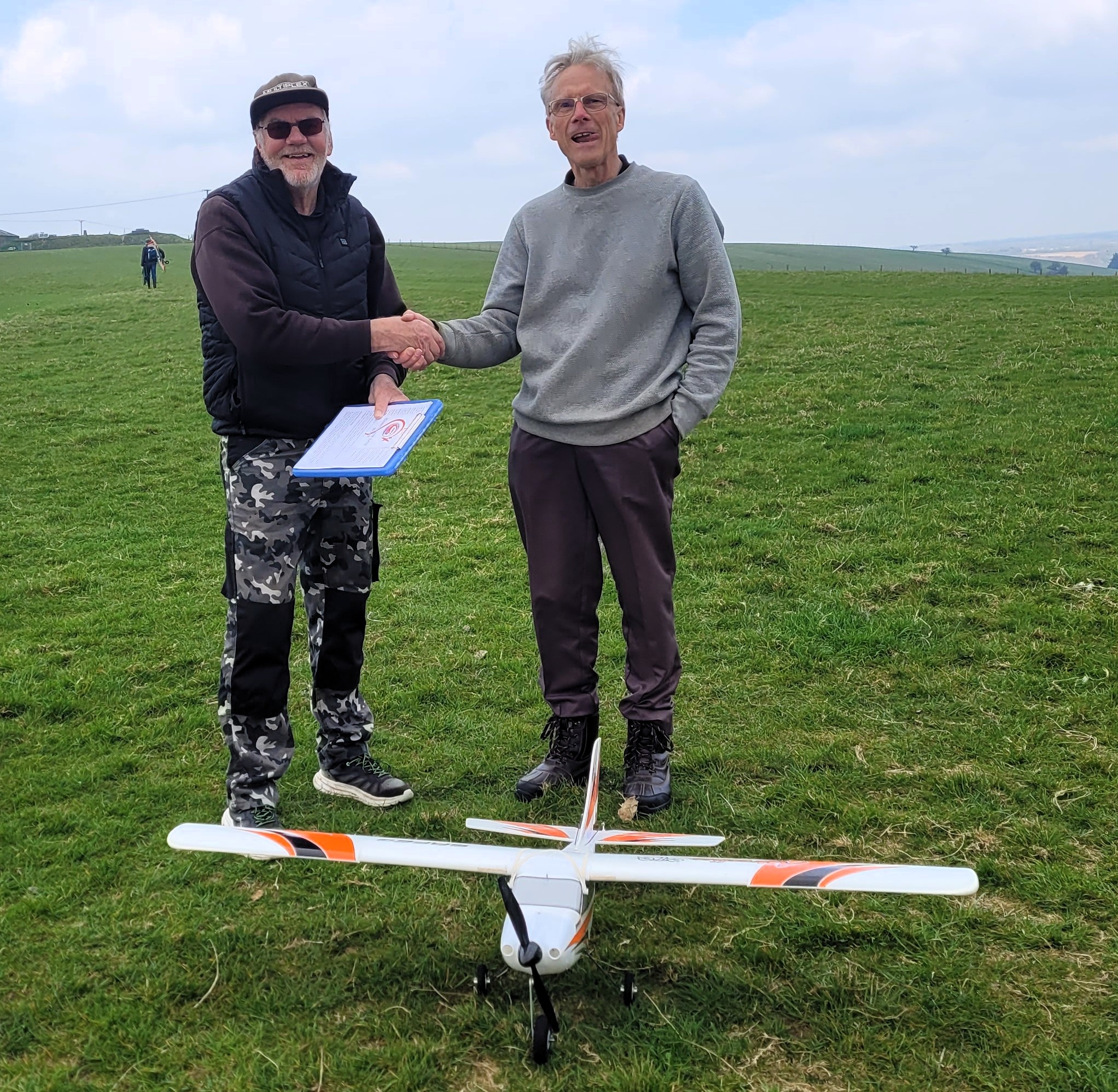 After a couple of practise run throughs of the test Windshy bit the bullet, flew the test for real, answered the necessary questions and passed. So congratulations Windshy, it’s now time to look for a slightly more advanced model…no not a pylon racer or a Lancaster!
After a couple of practise run throughs of the test Windshy bit the bullet, flew the test for real, answered the necessary questions and passed. So congratulations Windshy, it’s now time to look for a slightly more advanced model…no not a pylon racer or a Lancaster!
Several new models were flown in March and there were also several older planes brought out of retirement to fly again. The first to fly was Page Boy’s Woodpecker that I featured back in January as finished but not yet flown. Page Boy had started the build back in 2018 so there didn’t seem too much of a rush to get it in the air the moment it was completed. But on 2nd March the Woodpecker finally arrived at the field and took to the air.
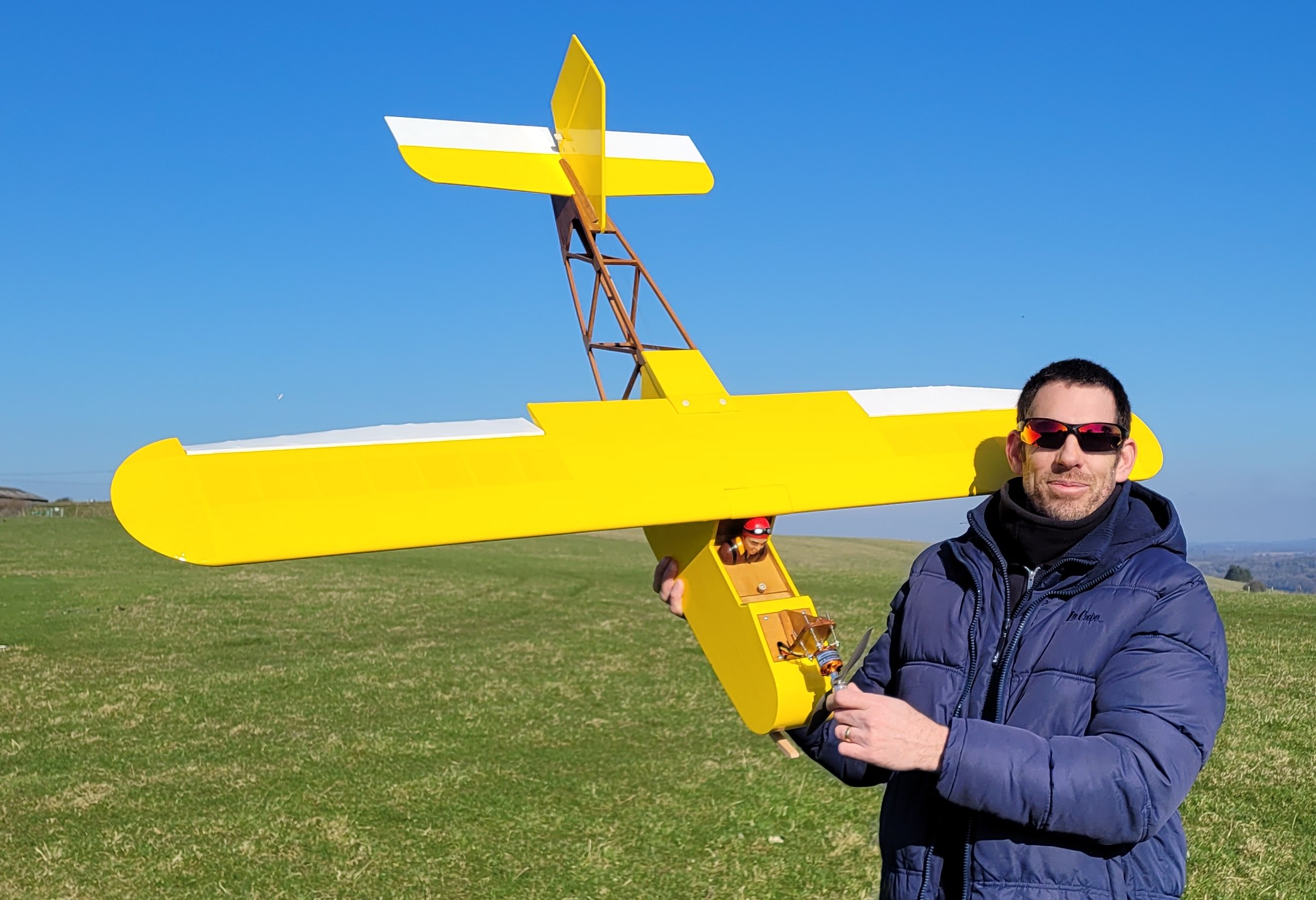
 I was surprised when I first saw it as, at 66” span, it was much larger than I had realised from the photos Page Boy had sent me. The Woodpecker was designed by Lindsay Todd and Paul Rice and the original used a 900kv motor and a 3 cell lipo but Page Boy has fitted a 3536 1250kv Turnigy motor and he’s using a 3300mAh 4 cell lipo which avoids the need for a lot of weight in the nose and gives flight times of around 6 or 7 minutes.
I was surprised when I first saw it as, at 66” span, it was much larger than I had realised from the photos Page Boy had sent me. The Woodpecker was designed by Lindsay Todd and Paul Rice and the original used a 900kv motor and a 3 cell lipo but Page Boy has fitted a 3536 1250kv Turnigy motor and he’s using a 3300mAh 4 cell lipo which avoids the need for a lot of weight in the nose and gives flight times of around 6 or 7 minutes.
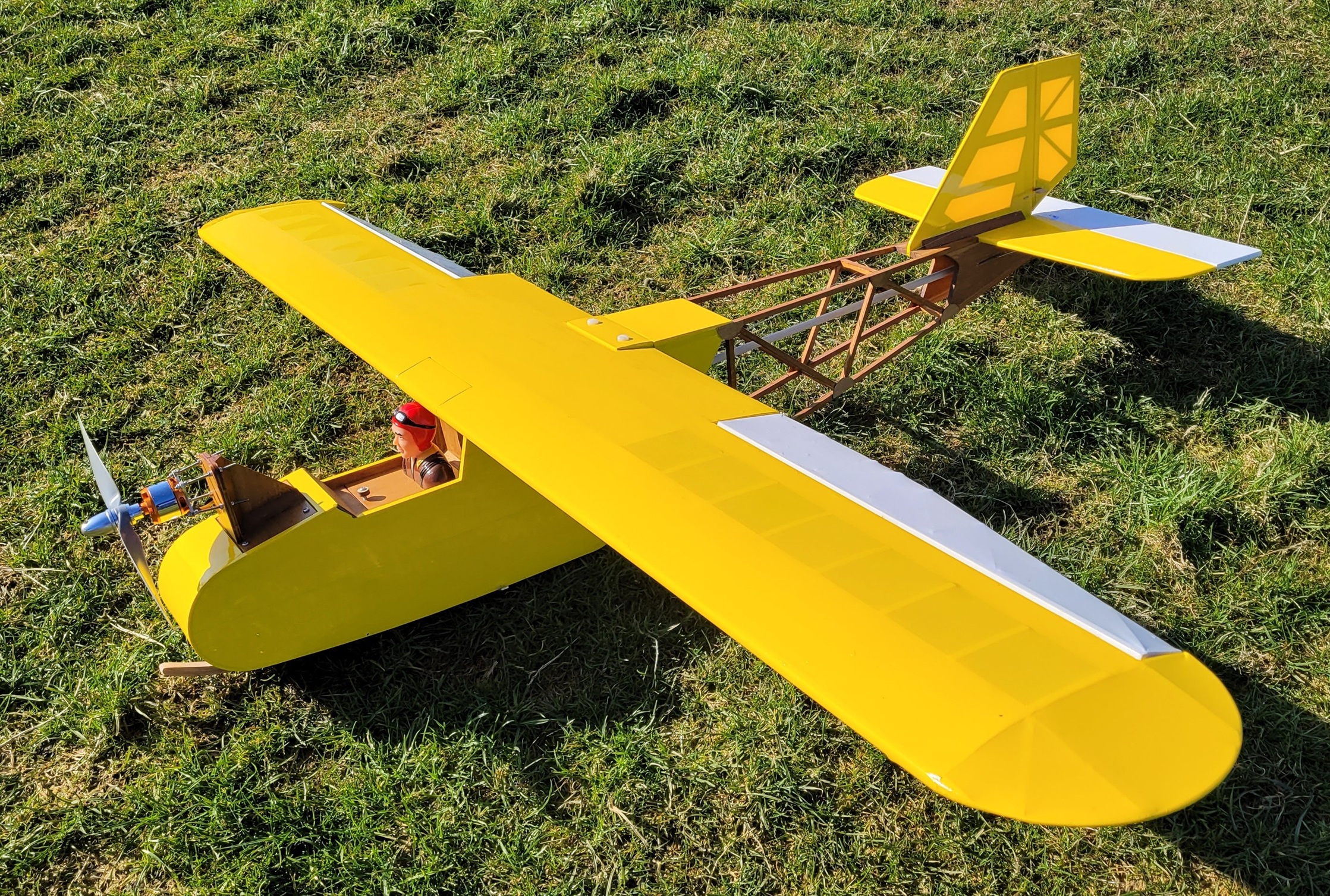 The speed controller is a 60A Turnigy unit and he’s using 4-Max servos for all control surfaces. The first flight looked reasonable but Page Boy said he was struggling as the motor had too much downthrust. As the motor is mounted on a pylon it’s easy to adjust so before the next flight the downthrust was removed and the second flight went much better.
The speed controller is a 60A Turnigy unit and he’s using 4-Max servos for all control surfaces. The first flight looked reasonable but Page Boy said he was struggling as the motor had too much downthrust. As the motor is mounted on a pylon it’s easy to adjust so before the next flight the downthrust was removed and the second flight went much better. 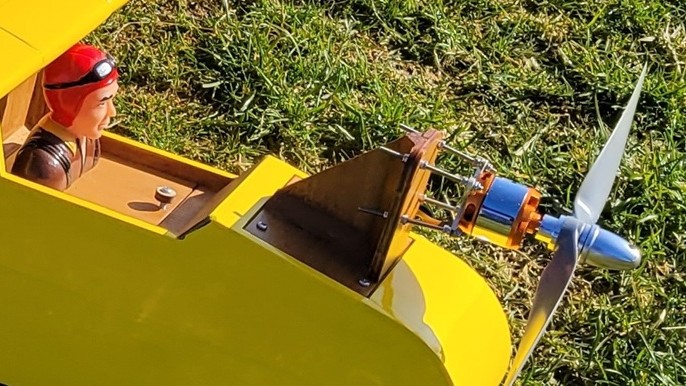 You can see the Woodpecker flying after the changes had been made in this month’s video.
You can see the Woodpecker flying after the changes had been made in this month’s video.
Also featured in the January Patch News but unflown was Captain Slow’s Piwakawaka.
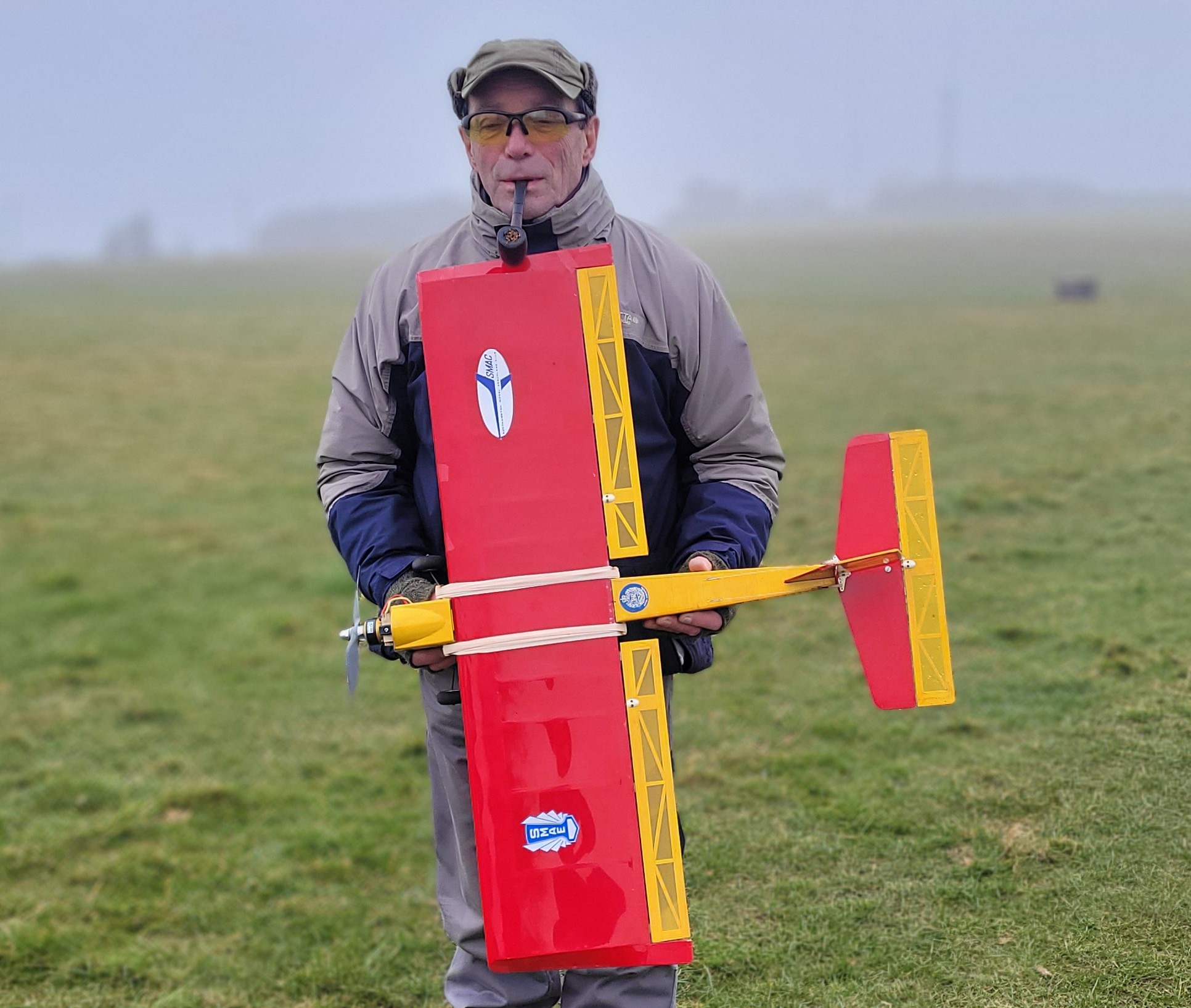 He bought it second-hand from a modeller in Southampton so it has flown previously. It seems very successful, Captain Slow had several flights with it in March with no problems. He’s been using a 3 cell 2200mAh pack but even after two flights on the same battery he’s still landing with around 40% left so he’s thinking of trying it with a 1300mAh instead.
He bought it second-hand from a modeller in Southampton so it has flown previously. It seems very successful, Captain Slow had several flights with it in March with no problems. He’s been using a 3 cell 2200mAh pack but even after two flights on the same battery he’s still landing with around 40% left so he’s thinking of trying it with a 1300mAh instead.
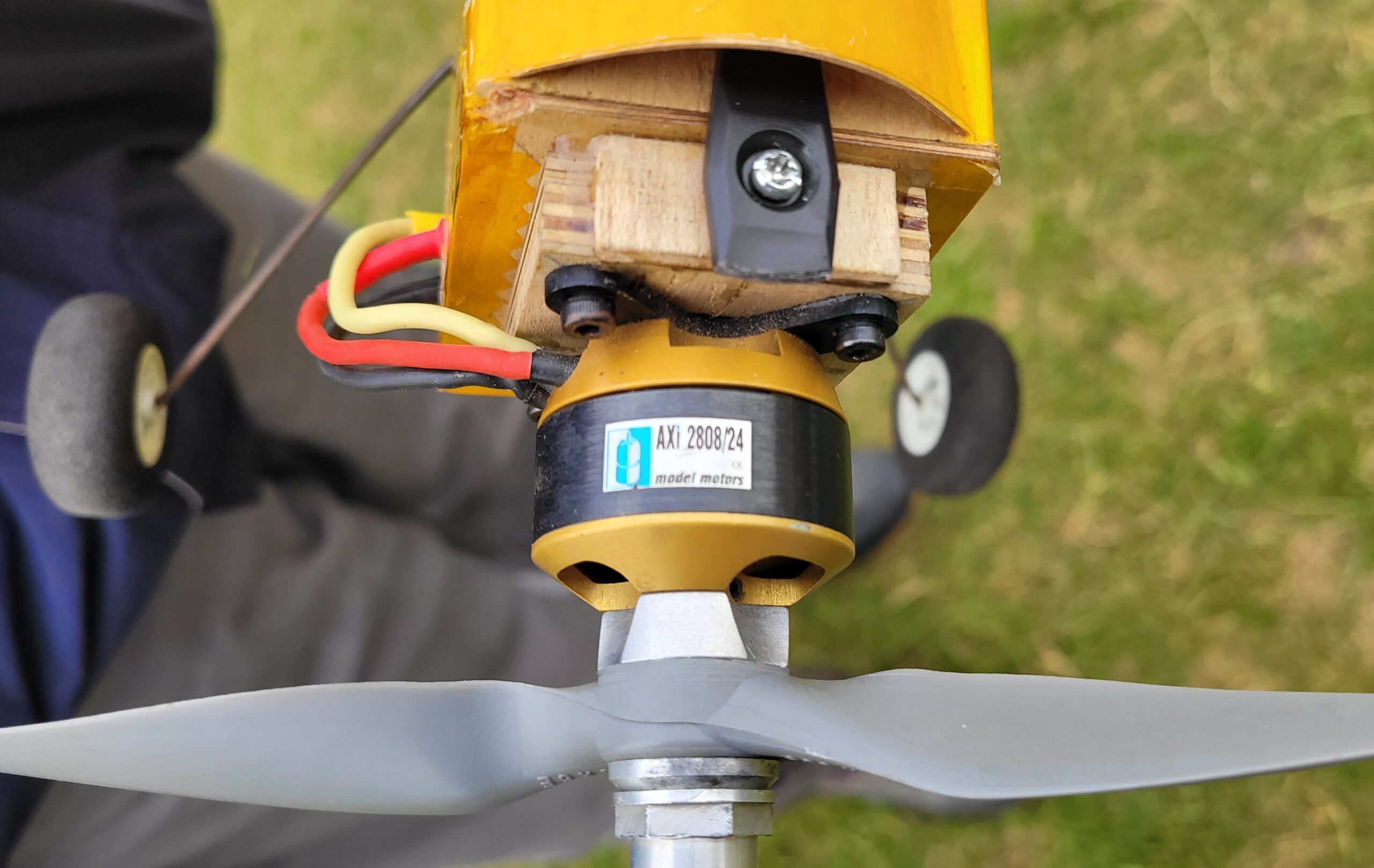 I was going to suggest moving the throttle stick up beyond the mid position occasionally but I wouldn’t want to scare him and then have to change his name to Captain Medium!
I was going to suggest moving the throttle stick up beyond the mid position occasionally but I wouldn’t want to scare him and then have to change his name to Captain Medium!
The next new model to fly was John Warren’s XFly Tasman. John was after something nice and easy to fly and Bob the Builder suggested the Tasman as he loves his own and finds it very easy. John asked me to do the trimming flight which went perfectly other than it briefly disappearing briefly in the mist/low cloud… not the ideal day for a test flight!
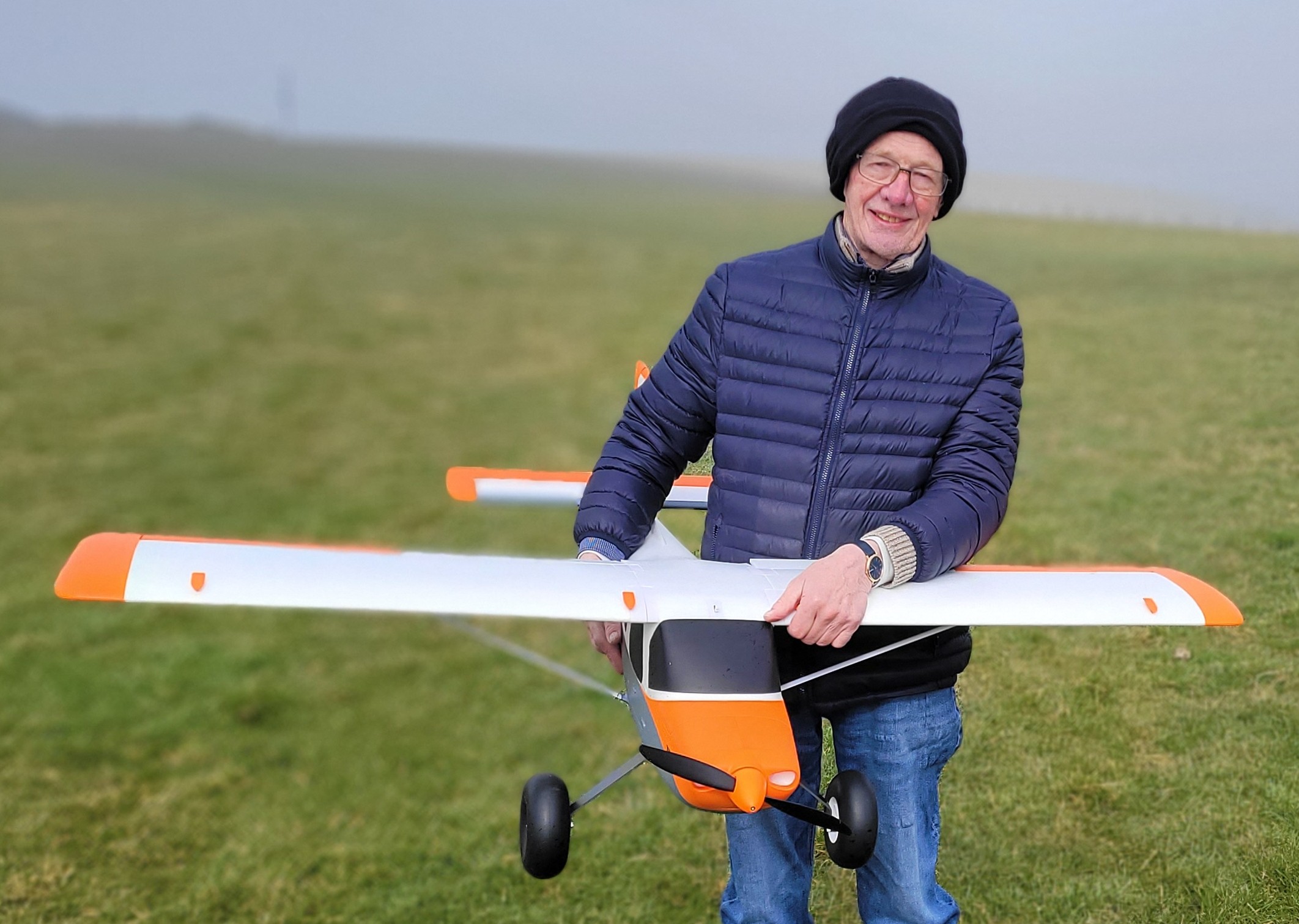
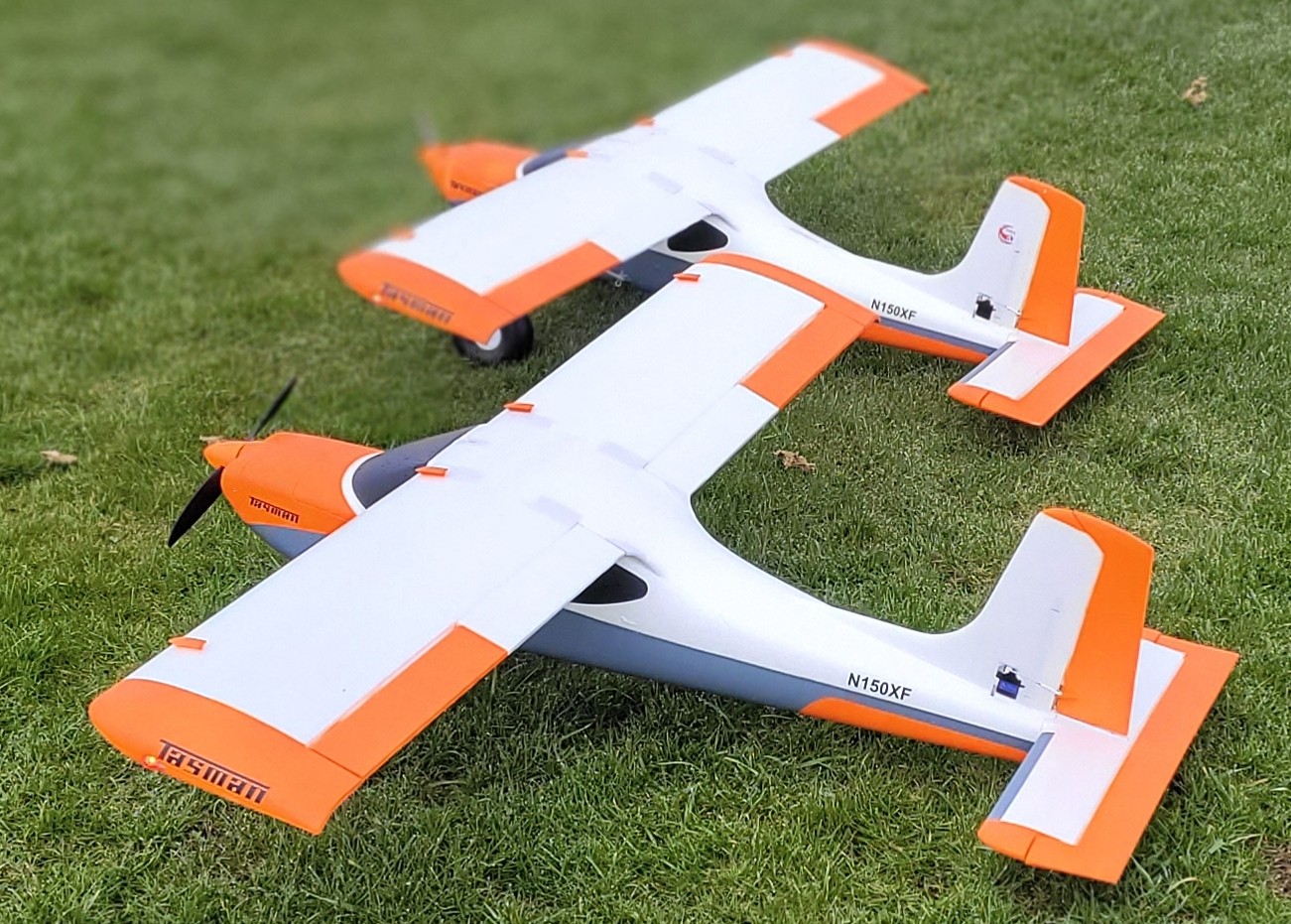 Apart from the murky weather at the start of the flight all was good and John has now had several flights with no problems, the Tasman is the perfect model for John. Both Tasmans are in the video which is slightly confusing but I think I’ve got the captions correct.
Apart from the murky weather at the start of the flight all was good and John has now had several flights with no problems, the Tasman is the perfect model for John. Both Tasmans are in the video which is slightly confusing but I think I’ve got the captions correct.
At the end of February 1066 broke his VisionAire in half when a low inverted pass went just a tad too low and, much to his annoyance, I snuck a couple of photos into Patch News!
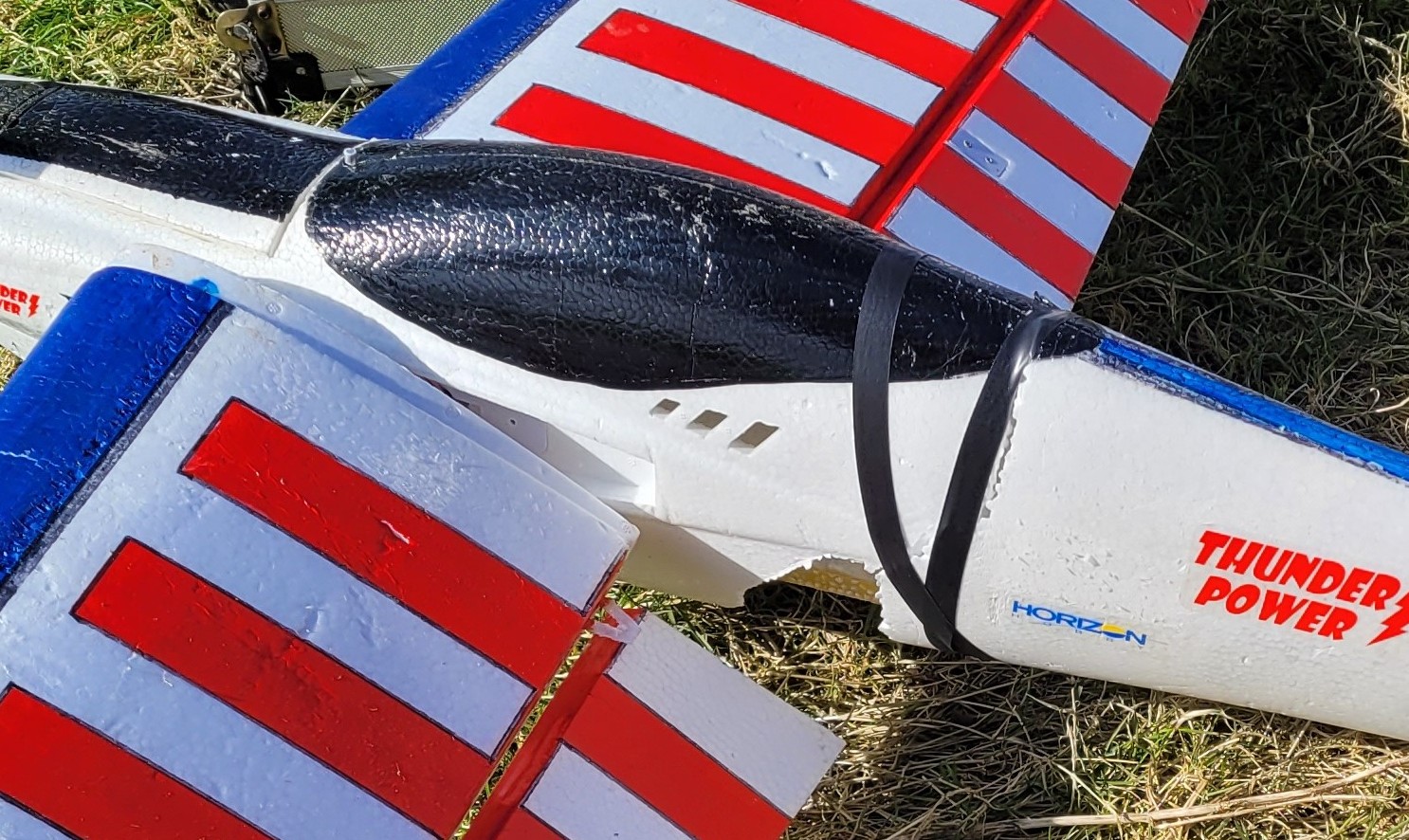 Well 1066 put his repairing hat on and soon had everything back in one piece and looking almost as good as before so it seems only fair for me to show you another photo of it.
Well 1066 put his repairing hat on and soon had everything back in one piece and looking almost as good as before so it seems only fair for me to show you another photo of it.
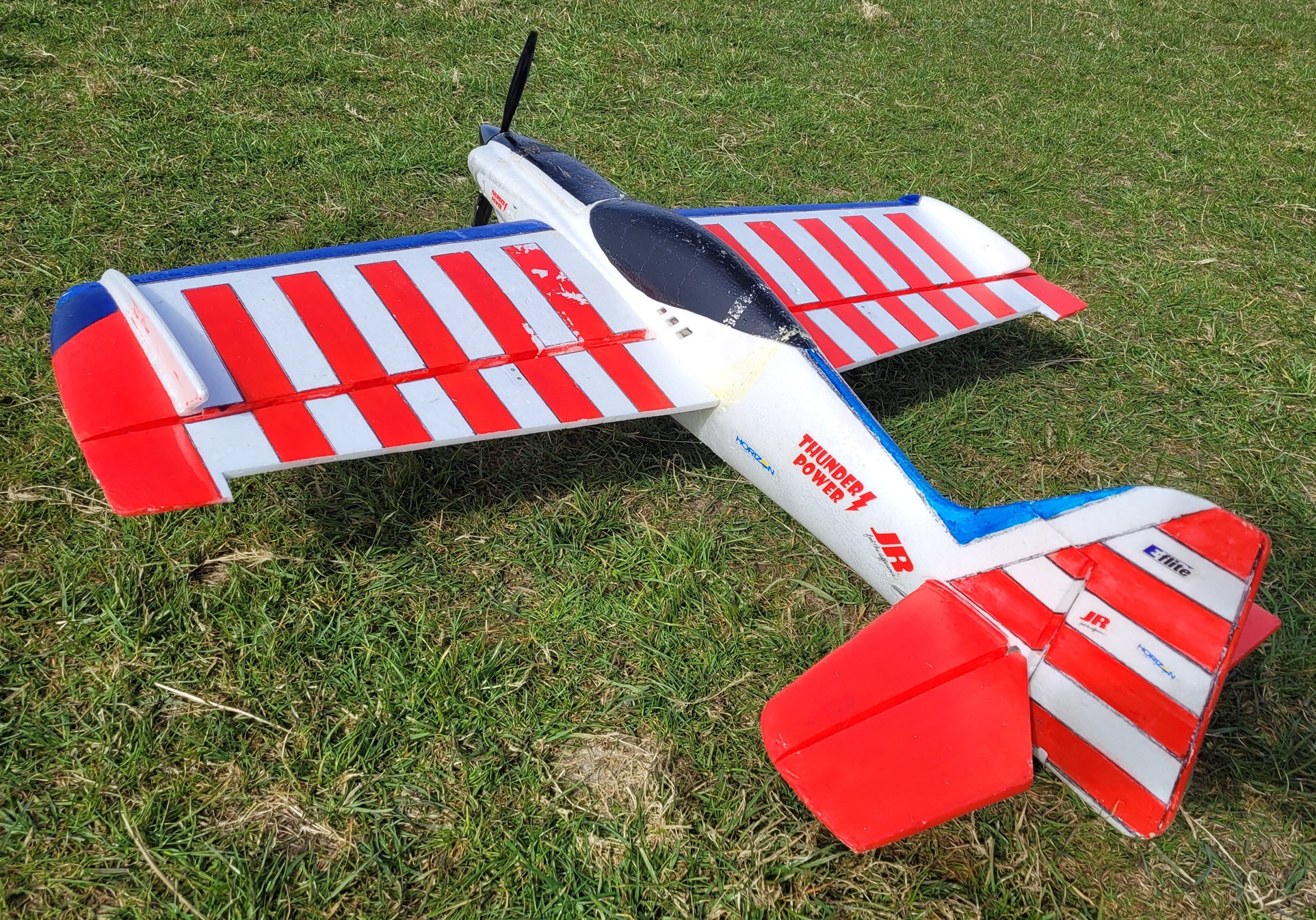 The VisionAire now flies just as well as it did before it’s minor misadventure but oddly 1066 kept refusing to do any low inverted passes with it this month, I can’t think why!
The VisionAire now flies just as well as it did before it’s minor misadventure but oddly 1066 kept refusing to do any low inverted passes with it this month, I can’t think why!
Back to new models now and another from Page Boy, this time an Arrows Hobby Avanti. 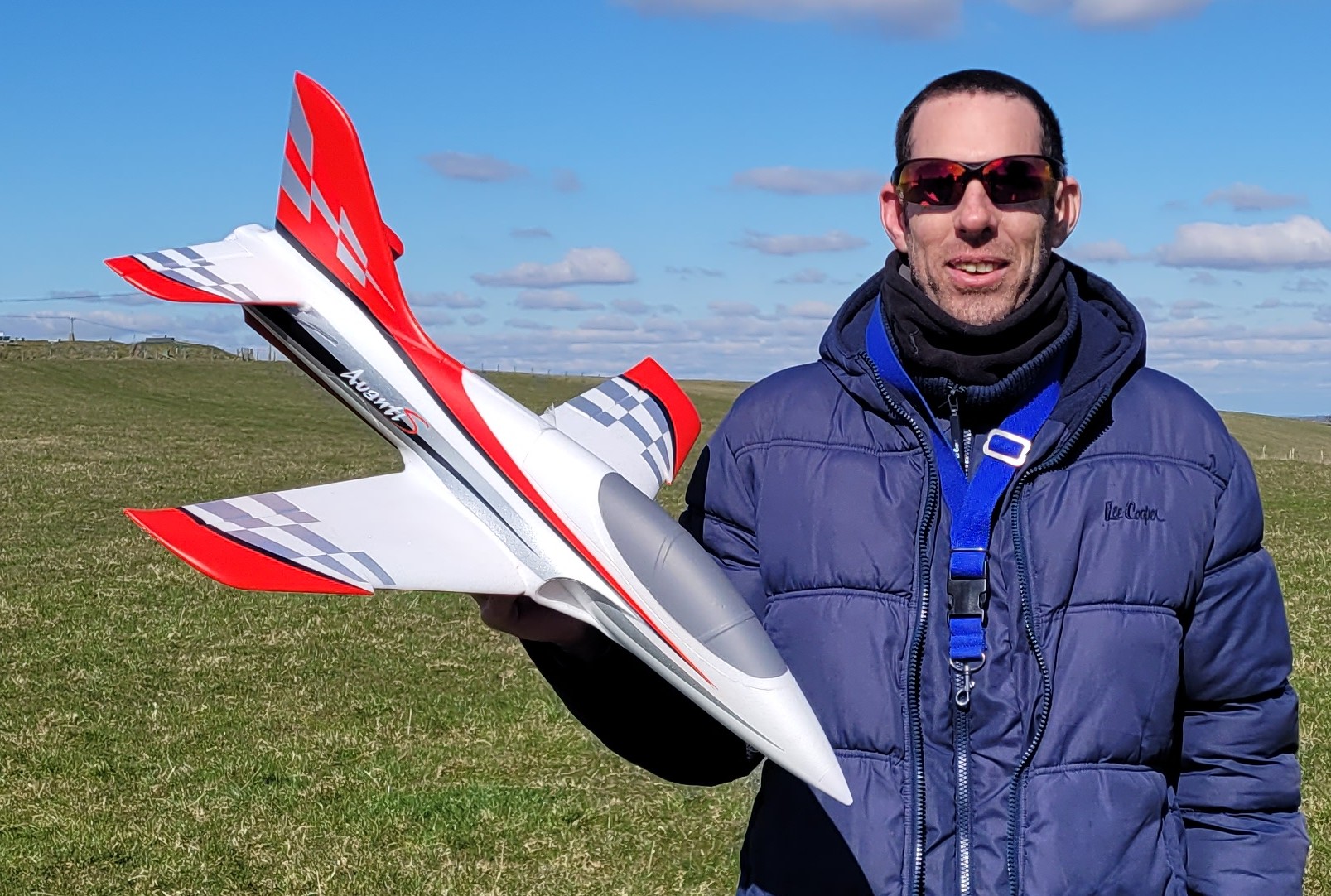 Unlike the Woodpecker that took seven years to make it from plan to play the Avanti was bought and flown in the same month. The EPO foam Avanti comes almost finished with an 11 blade fan, 2627 4500kv motor, 30A esc, 6 axis gyro, and 3x9g servos all pre-installed.
Unlike the Woodpecker that took seven years to make it from plan to play the Avanti was bought and flown in the same month. The EPO foam Avanti comes almost finished with an 11 blade fan, 2627 4500kv motor, 30A esc, 6 axis gyro, and 3x9g servos all pre-installed. 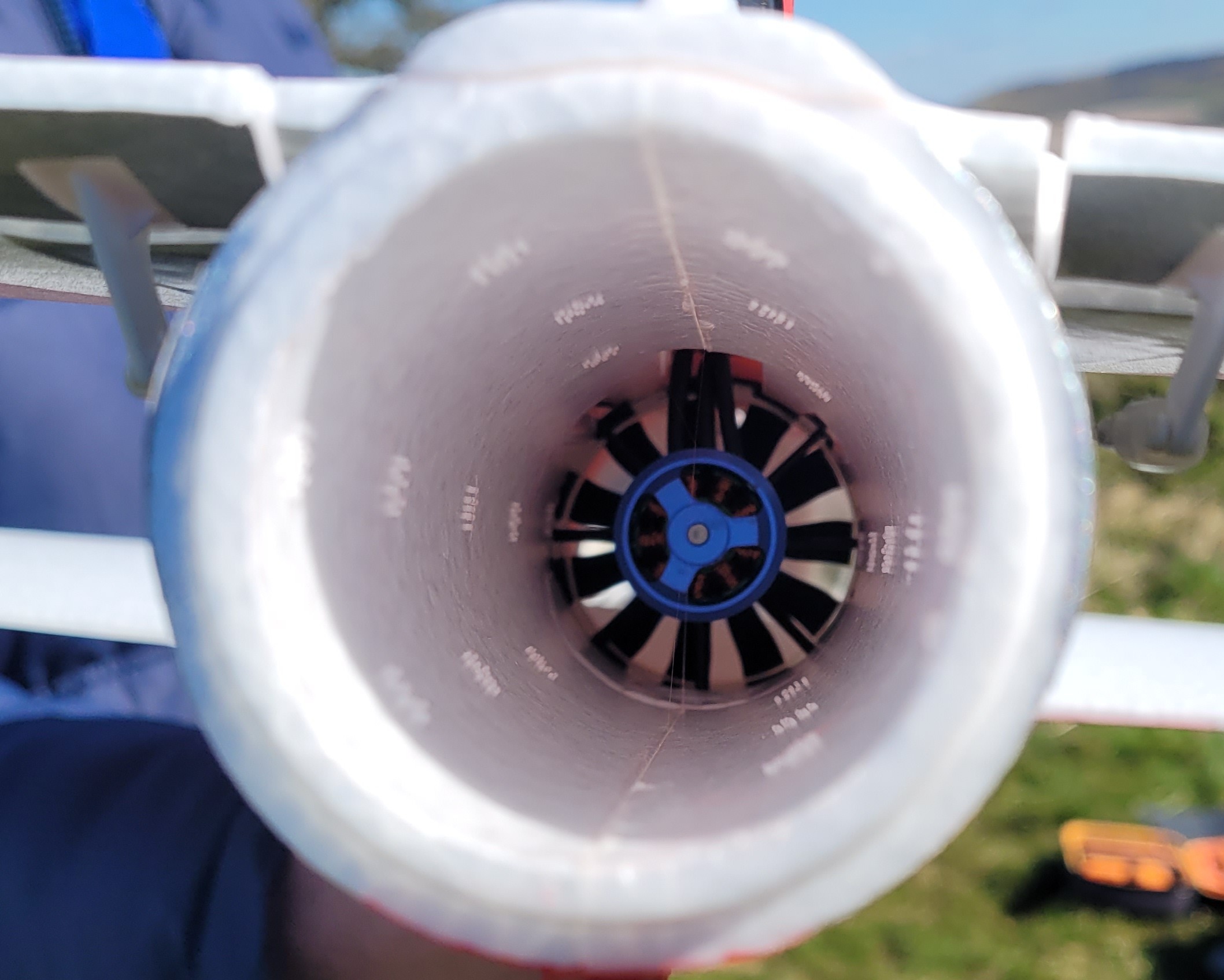
 The instructions say just thirty minutes assembly time so buying and flying in the same month should have been easy. This is what the Wheelspin Models website says about it:
The instructions say just thirty minutes assembly time so buying and flying in the same month should have been easy. This is what the Wheelspin Models website says about it:
Where good-looking, top performing, 50mm EDF sport jets are concerned, little can beat the locked-in, arrow-like characteristics of the Arrows Avanti. ‘If it looks right, it’ll fly right they say and in this instance there’s never been a truer word. Sporting Arrows highly-regarded, jet-like 50mm 11-blade fan and 2627 4500KV brushless motor combo, this 3S-fuelled slick ship will appeal to all who seek smooth, torque-free aerobatics, benign handling and a ‘go where you put it’ performance. OK, got that Page Boy?!
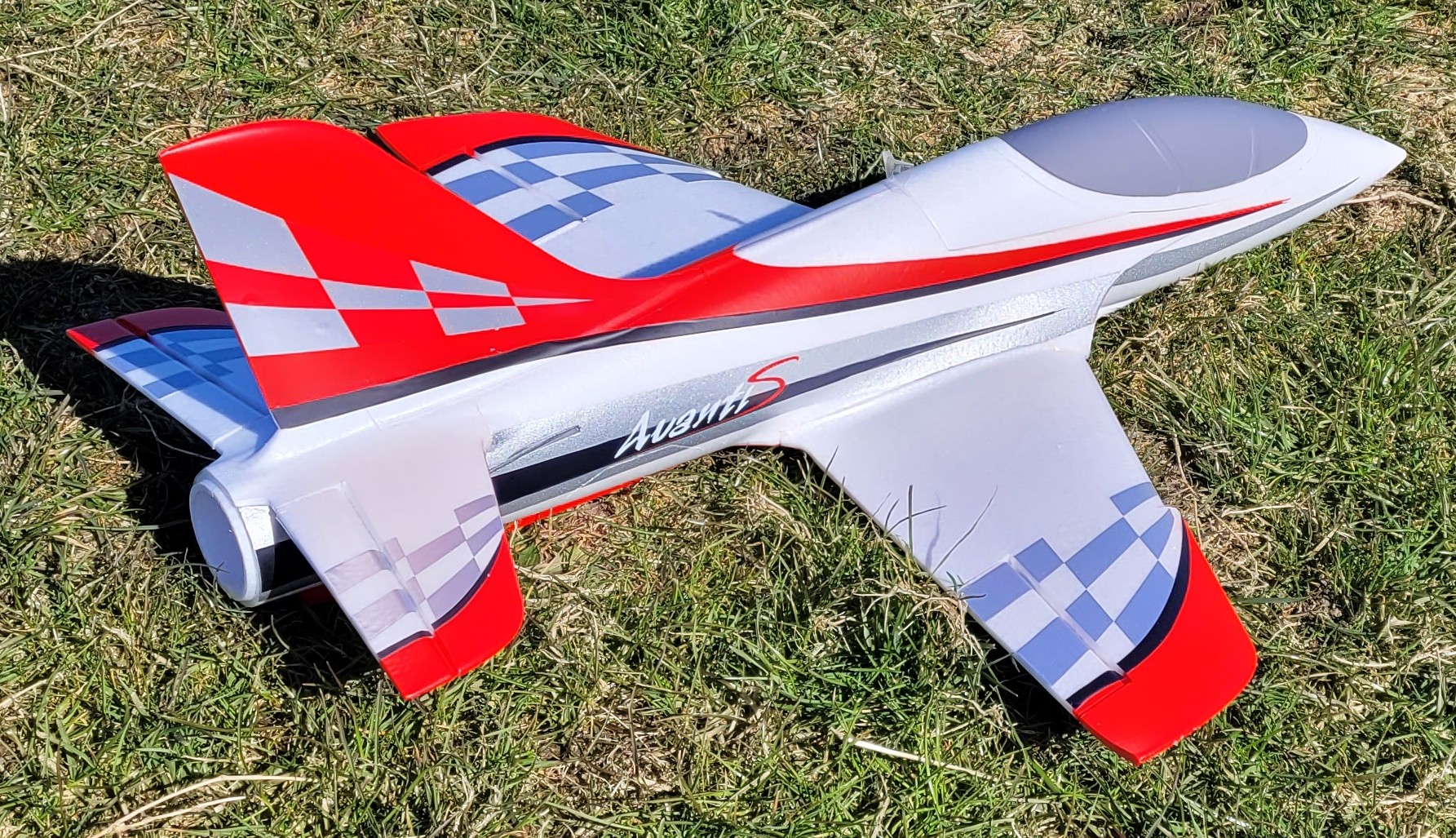 It was quite a windy day that Page Boy test flew his Avanti with some pretty turbulent air so the stabiliser was working hard but all went well and it looked great on the air. Mini Mike also has one of these and they can both be seen flying in this month’s video.
It was quite a windy day that Page Boy test flew his Avanti with some pretty turbulent air so the stabiliser was working hard but all went well and it looked great on the air. Mini Mike also has one of these and they can both be seen flying in this month’s video.
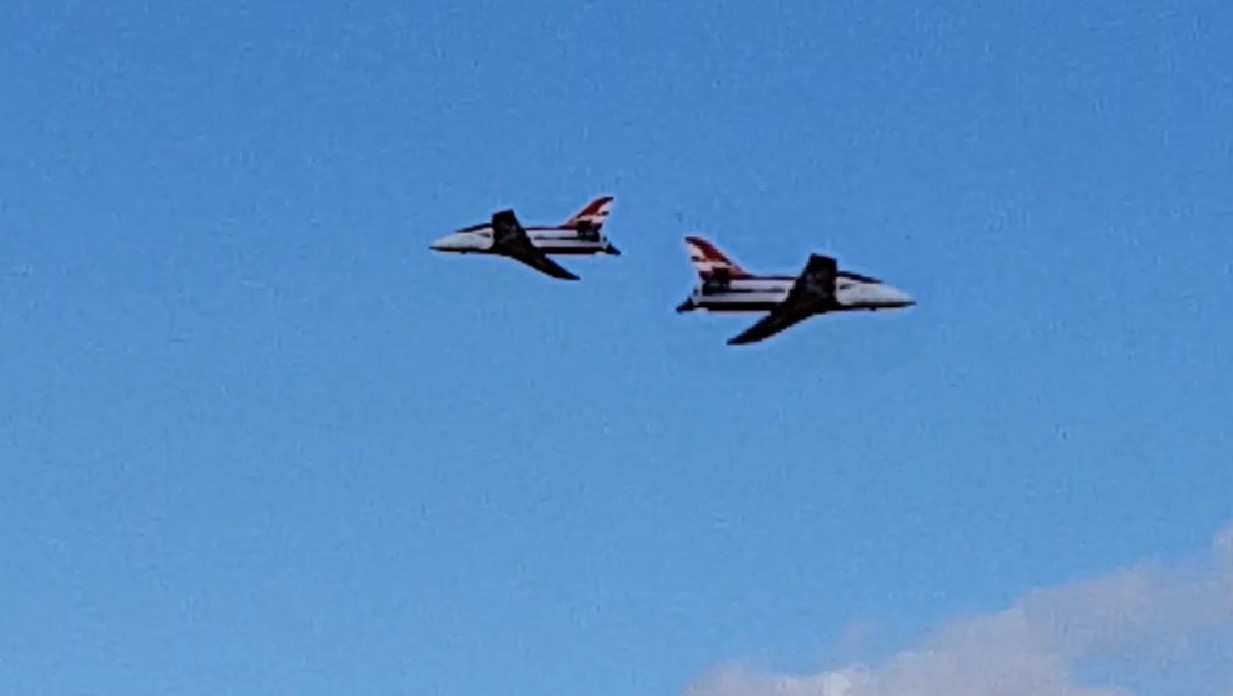 They were very lucky not to have a mid-air at one point, I captured this rather blurry screenshot from the video, Page Boy’s is the nearest one. He reckoned it must have been Mini Mike’s fault as he was feeling a bit under the weather at the time…poorly lad, as if!
They were very lucky not to have a mid-air at one point, I captured this rather blurry screenshot from the video, Page Boy’s is the nearest one. He reckoned it must have been Mini Mike’s fault as he was feeling a bit under the weather at the time…poorly lad, as if!
I mentioned earlier that Bob the Builder has an XFly Tasman that he’s been flying for a while and he likes it so much that he’s now designed and built himself a mini version of it. 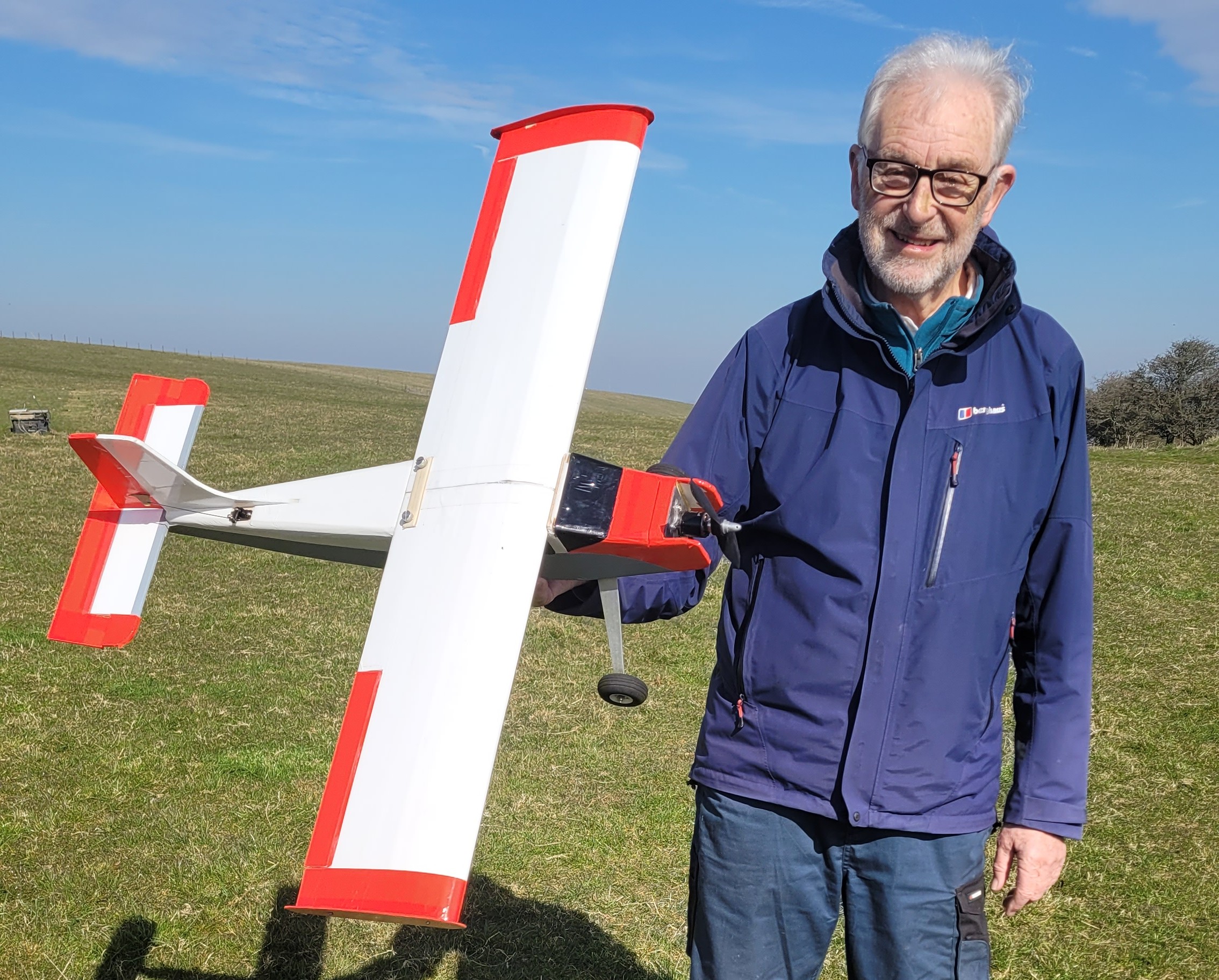 This is what he says about it: Decided I needed to replace my old Basher with something easier to fly. What could be better than a Mini Tasman. I love my big Tasman so decided to scale it down to run a 1300 3s battery. First thoughts were to scale down to 60%. Started making all the dimensions 60%. Wasn’t long before I realised that the wing area was much smaller than 60% which didn’t look right, in fact it was only 36% when you multiplied the wing span by the cord. Decided to change tack and make the area of all flying surfaces 50% of the original area. I watched several YouTube build videos that used 10mm Thermocol foamboard which seemed to make the build very quick and easy. Unfortunately Thermocol doesn’t appear to be available in the UK and the closest I could find was 5mm foam board from Hobbycraft. It was all built from this foam board but with added strength where required and all covered with white or red parcel tape.
This is what he says about it: Decided I needed to replace my old Basher with something easier to fly. What could be better than a Mini Tasman. I love my big Tasman so decided to scale it down to run a 1300 3s battery. First thoughts were to scale down to 60%. Started making all the dimensions 60%. Wasn’t long before I realised that the wing area was much smaller than 60% which didn’t look right, in fact it was only 36% when you multiplied the wing span by the cord. Decided to change tack and make the area of all flying surfaces 50% of the original area. I watched several YouTube build videos that used 10mm Thermocol foamboard which seemed to make the build very quick and easy. Unfortunately Thermocol doesn’t appear to be available in the UK and the closest I could find was 5mm foam board from Hobbycraft. It was all built from this foam board but with added strength where required and all covered with white or red parcel tape.
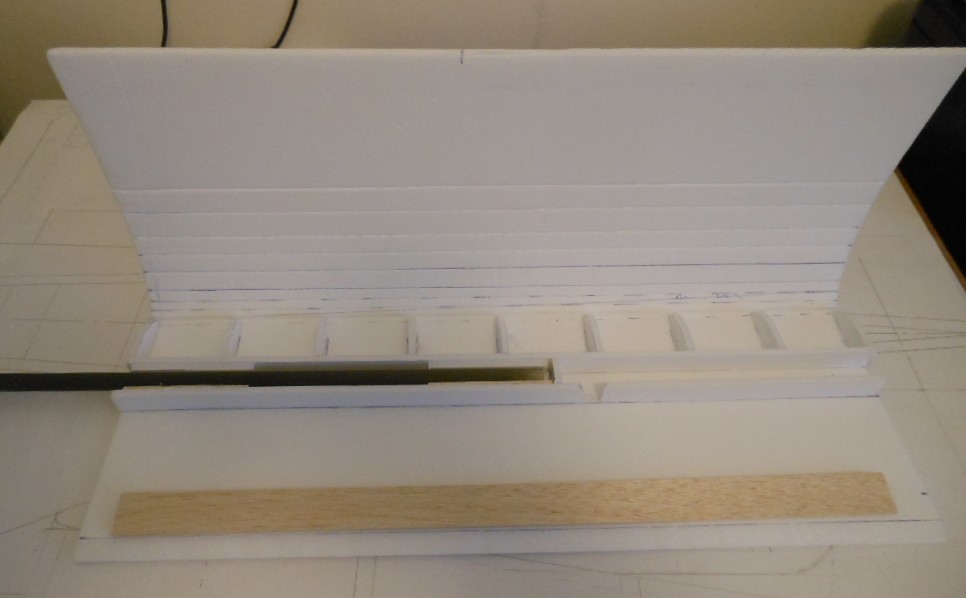
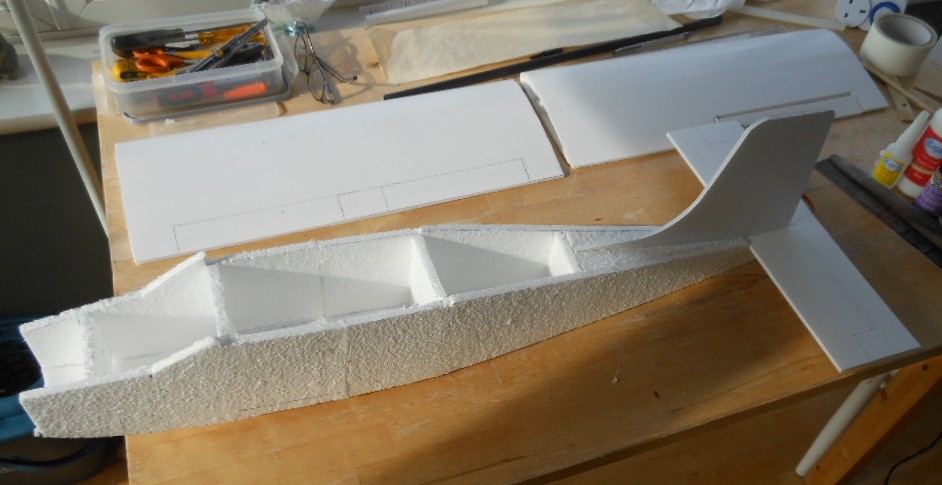
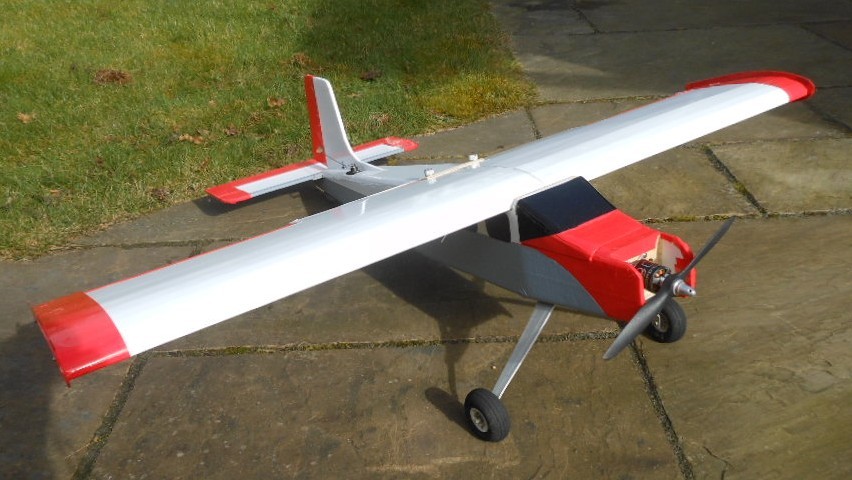 The fuselage bottom has been sprayed with grey paint. Technical data: Wingspan 1000mm, flying weight with 1300 3cell =1065grm, motor is a Hobbyking Propdrive 28/36 1400KV with a 9×6 Prop at 270 watts, 4 servos of 11grms. No flaps or wing struts yet and I need bigger wheels. A little more than half the weight of big Tasman with half the wing area so should fly OK but not quite as slow. Thanks Bob. To save weight Bob has removed the paper covering from much of the foam by soaking it in water. The pics show the construction method well, including the folded over wing profile and carbon joiner.
The fuselage bottom has been sprayed with grey paint. Technical data: Wingspan 1000mm, flying weight with 1300 3cell =1065grm, motor is a Hobbyking Propdrive 28/36 1400KV with a 9×6 Prop at 270 watts, 4 servos of 11grms. No flaps or wing struts yet and I need bigger wheels. A little more than half the weight of big Tasman with half the wing area so should fly OK but not quite as slow. Thanks Bob. To save weight Bob has removed the paper covering from much of the foam by soaking it in water. The pics show the construction method well, including the folded over wing profile and carbon joiner.
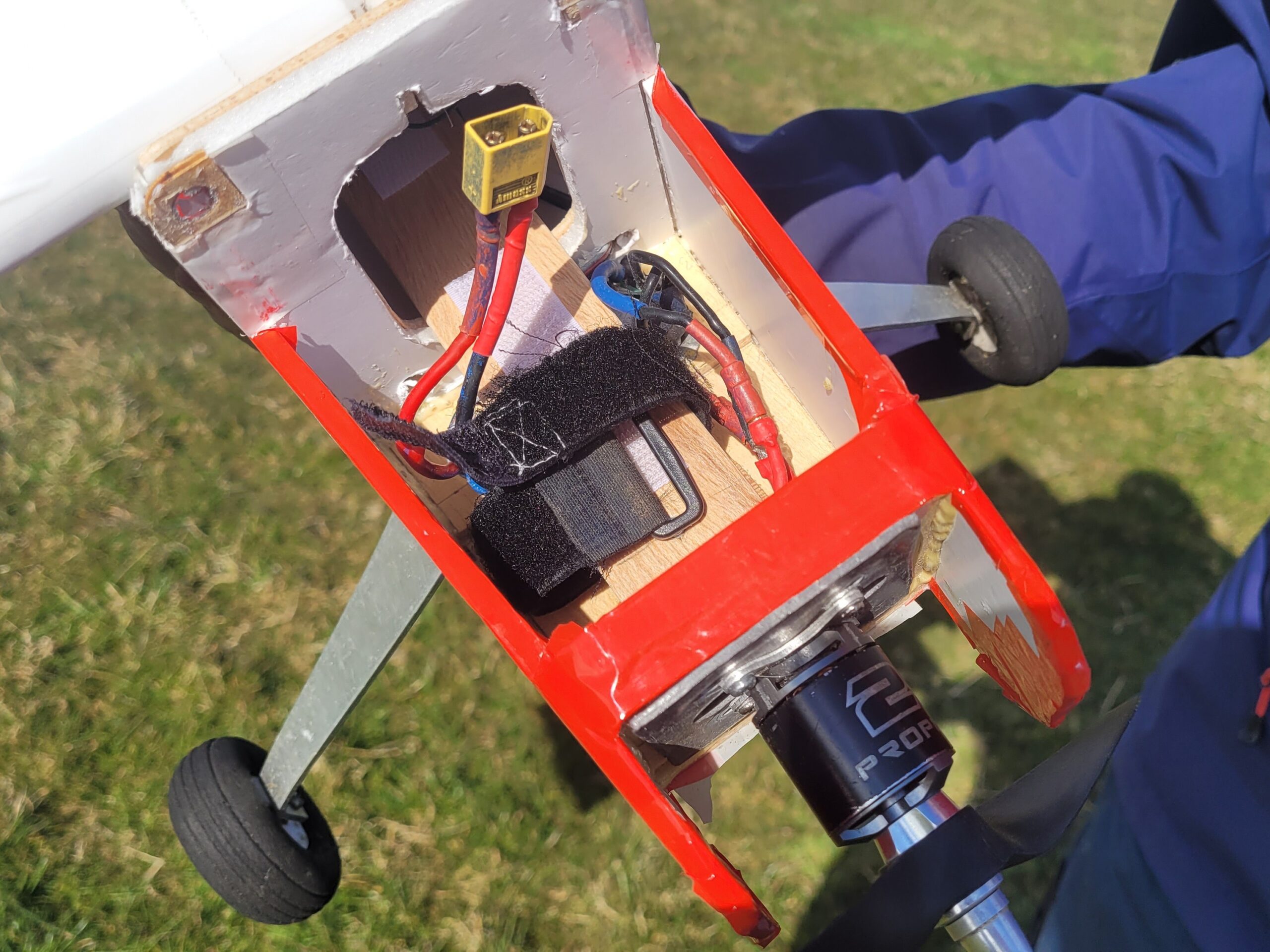 I did the initial trimming for Bob and the plane flew well. I then handed over to Bob and he flew it around for a few minutes before it suddenly dived into the ground. Bob wonders if he’d stalled it but I don’t think so, maybe something broke. The model was damaged but not too badly so Bob soon had it flying again. Everything appeared to be working perfectly but shortly after take-off the Mini Tasman lost radio contact and crashed again. It’s fairly easy to repair and Bob has changed the speed controller as that appears to have been the cause. He will of course give the whole thing a thorough check over before he tries again.
I did the initial trimming for Bob and the plane flew well. I then handed over to Bob and he flew it around for a few minutes before it suddenly dived into the ground. Bob wonders if he’d stalled it but I don’t think so, maybe something broke. The model was damaged but not too badly so Bob soon had it flying again. Everything appeared to be working perfectly but shortly after take-off the Mini Tasman lost radio contact and crashed again. It’s fairly easy to repair and Bob has changed the speed controller as that appears to have been the cause. He will of course give the whole thing a thorough check over before he tries again.
After taking a couple of months away from working on his Mirus 1066 finally got down to finishing and flying it in March. There were a few things he wasn’t happy about in the build, hence the delay, but now it’s all done and the end result looks good.
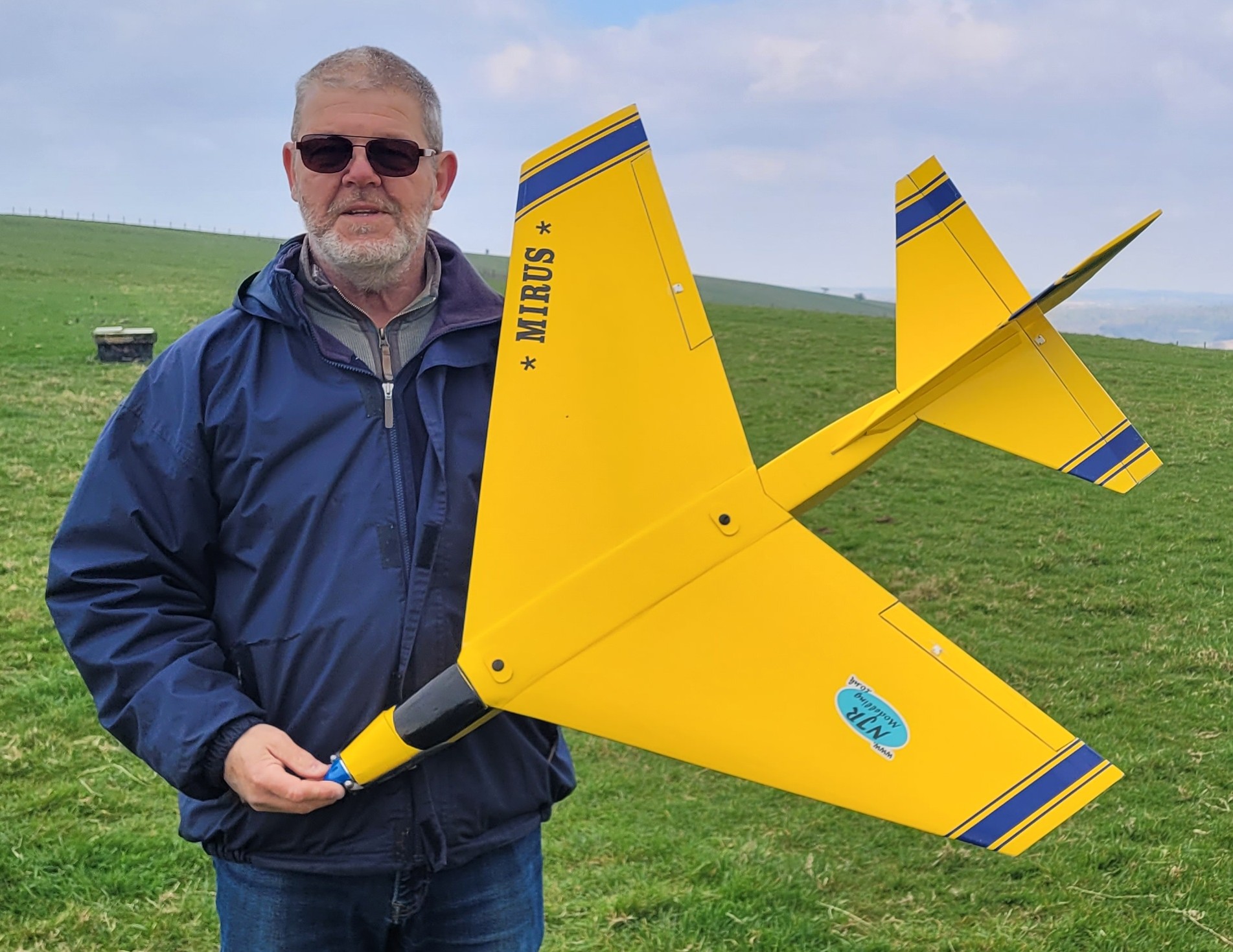 1066 says he had trouble with the covering on the underside and then found it tricky to see in the air so he’s jazzed it up with a few stickers, perfect! He’s fitted a 35mm 1000kv motor, a 70A speed controller, and powers it with a 4 cell 3300 or 3600mAh lipo battery.
1066 says he had trouble with the covering on the underside and then found it tricky to see in the air so he’s jazzed it up with a few stickers, perfect! He’s fitted a 35mm 1000kv motor, a 70A speed controller, and powers it with a 4 cell 3300 or 3600mAh lipo battery.
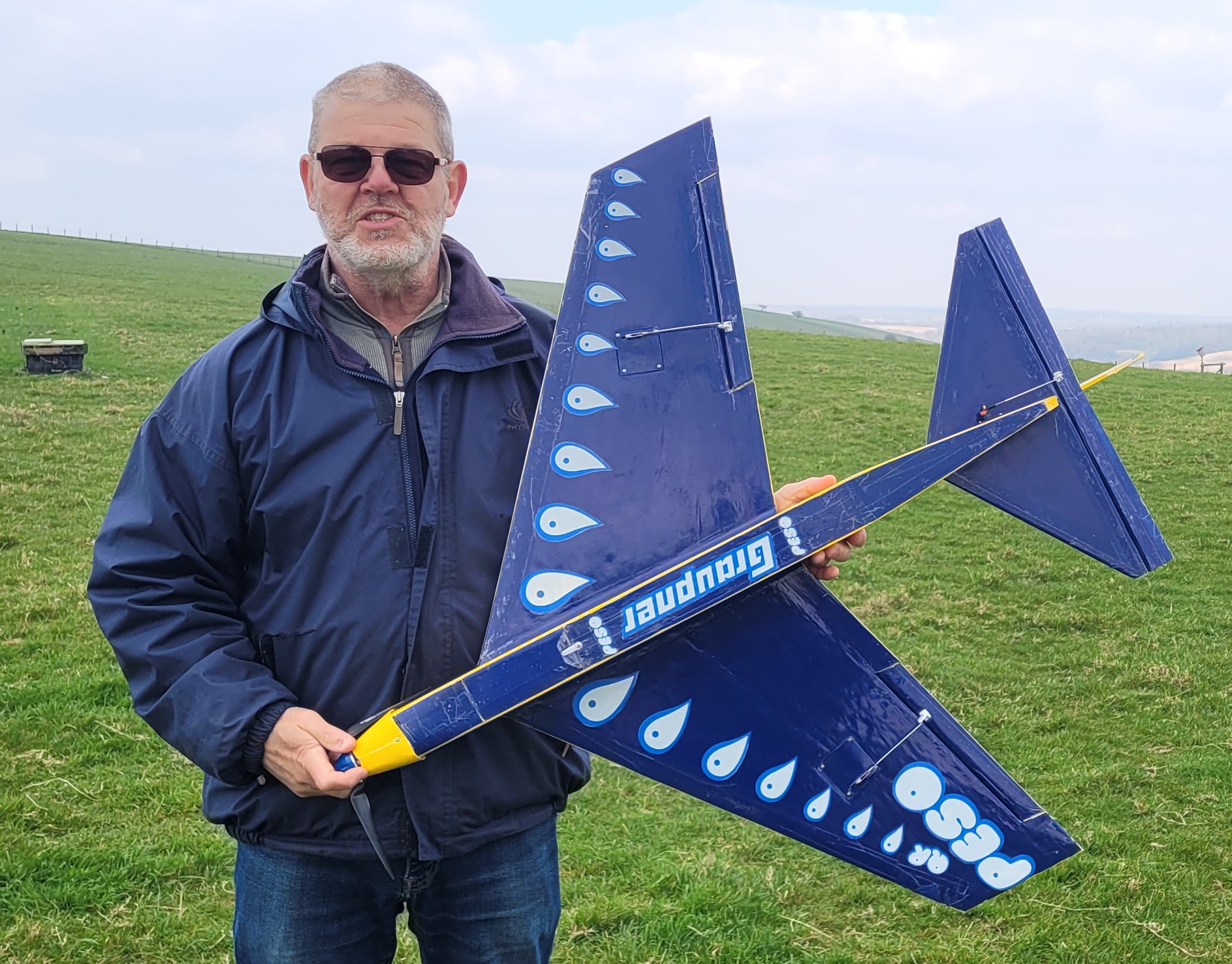 Knowing that it’s very easy to break the prop when landing a Mirus 1066 decided to try an Aeronaut folding prop and for the first flight he fitted a 12×8. The Mirus flew well but wasn’t as fast as he’d hoped, plus it was pulling close to the limit of the esc so he switched to an 11×6 folder which worked much better, more speed and a lower current draw.
Knowing that it’s very easy to break the prop when landing a Mirus 1066 decided to try an Aeronaut folding prop and for the first flight he fitted a 12×8. The Mirus flew well but wasn’t as fast as he’d hoped, plus it was pulling close to the limit of the esc so he switched to an 11×6 folder which worked much better, more speed and a lower current draw.
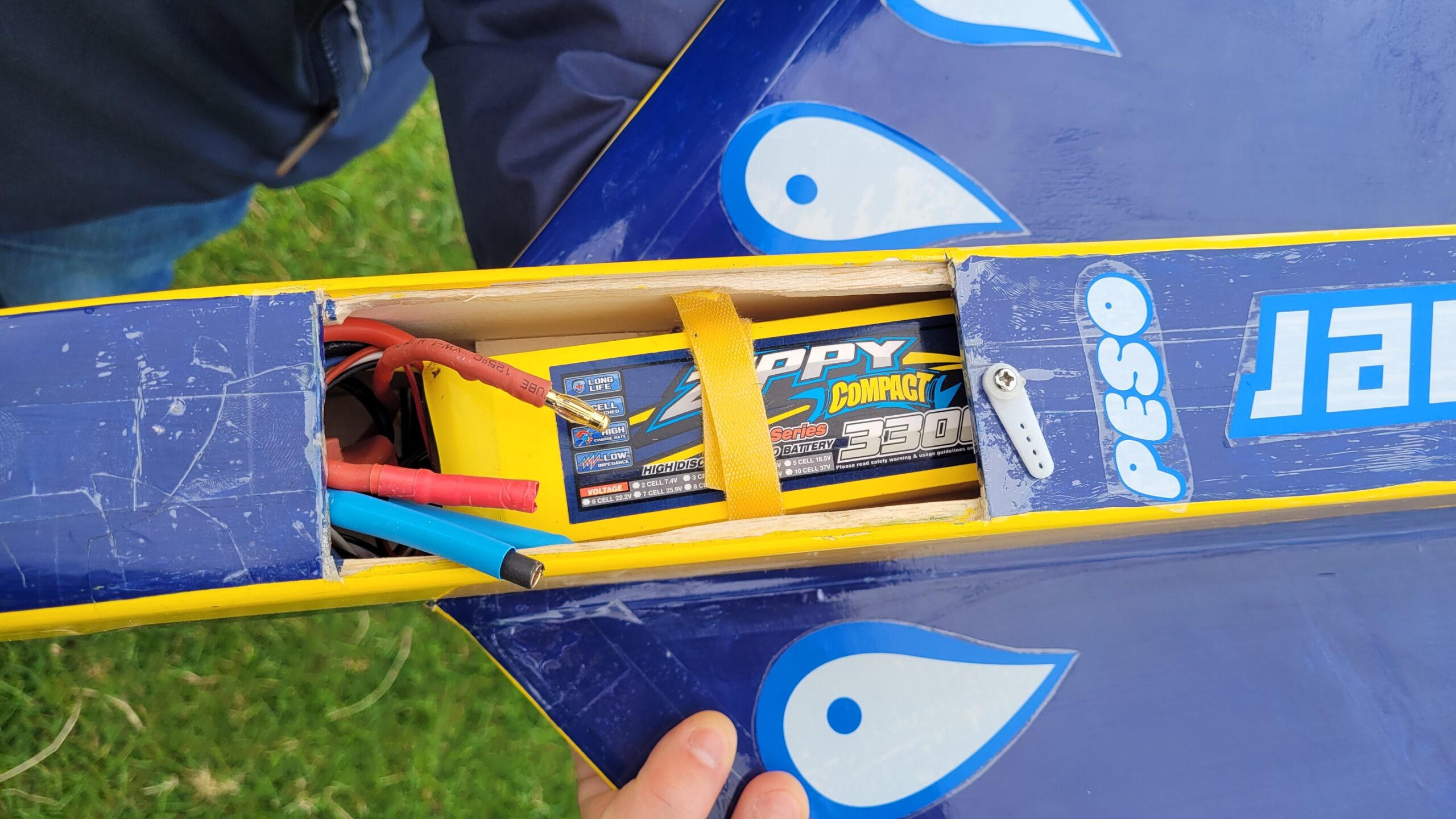 Having hand launched the Mirus a few times I can testify that it has a lot pull! You can see how it went on the first flight in this month’s video, on subsequent flights it was faster.
Having hand launched the Mirus a few times I can testify that it has a lot pull! You can see how it went on the first flight in this month’s video, on subsequent flights it was faster.
Last month I wrote that Woody was building a Yellow that he had bought as a plan and laser cut kit from Sarik Hobbies. He’s now finished the build and has finished it in blue covering. Woody has added some yellow trim in keeping with the Yellow name but just to confuse us all he is calling it Bluey instead. The covering is Ripmax heat shrink film.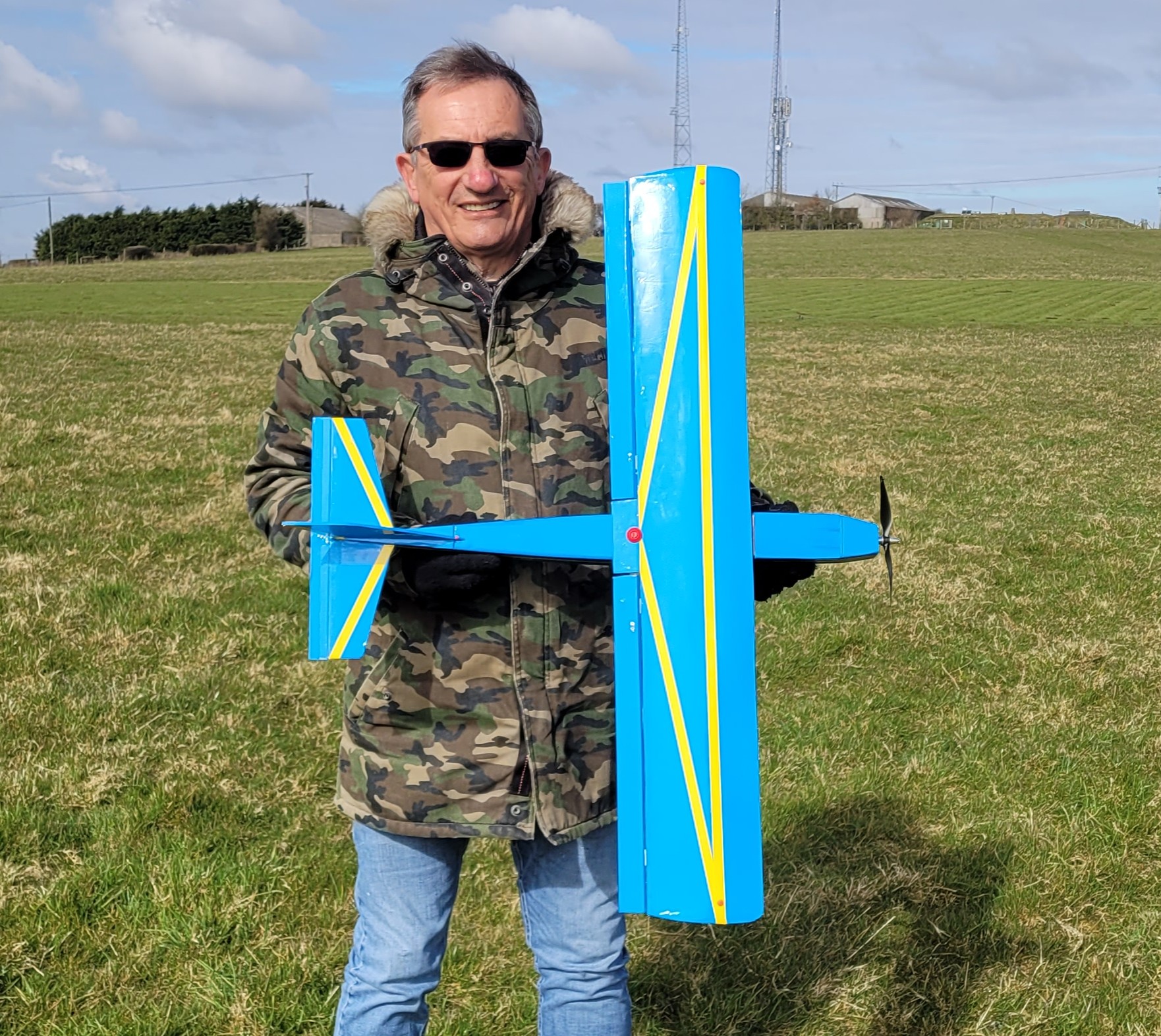
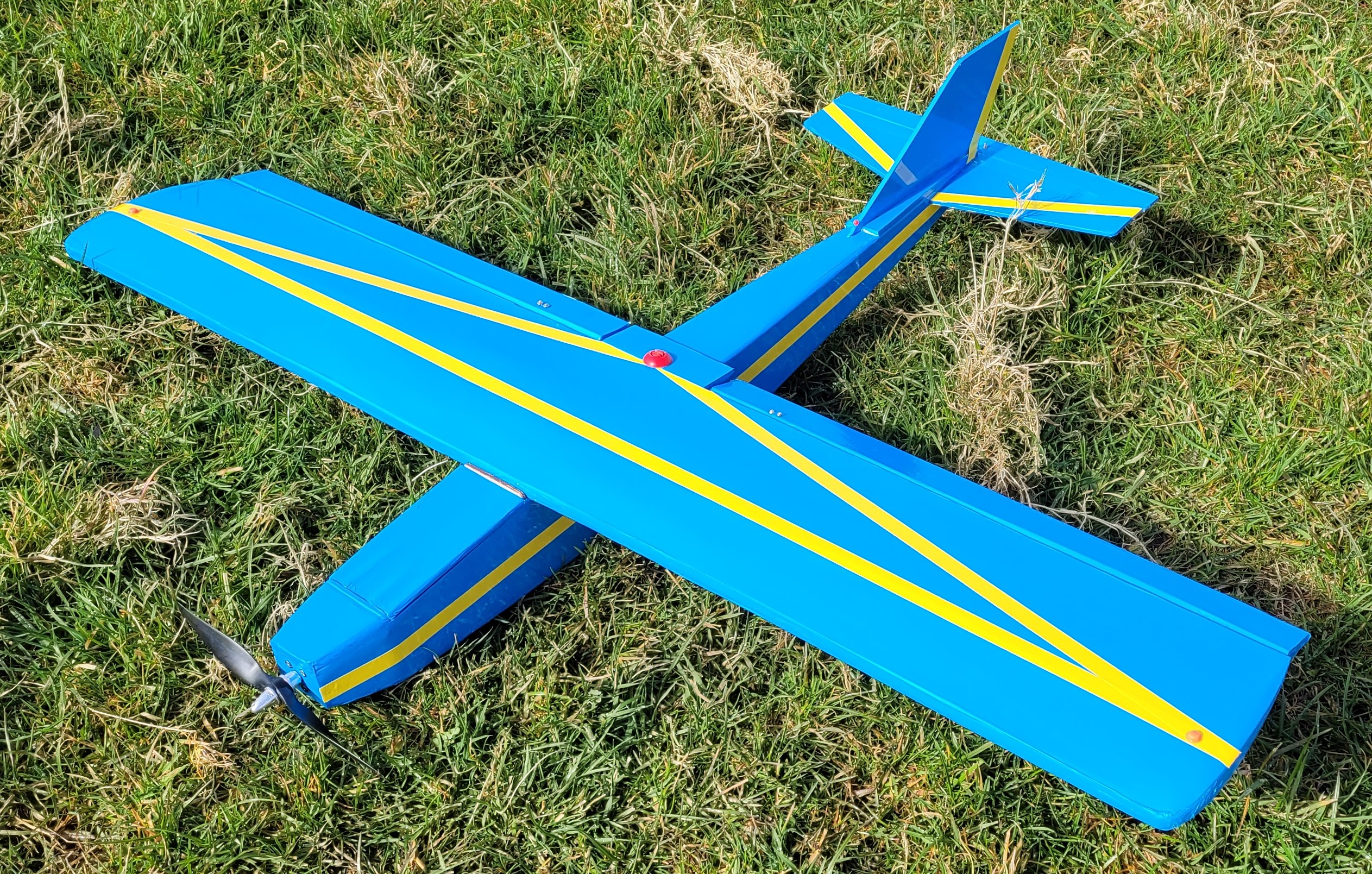
He has fitted a 2810 1400kv motor with a 7×5 propeller coupled to a 30A speed controller and is using a 3 cell 1000mAh lipo. Bluey had a few flights in March with no real problems but Woody is gradually making a few adjustments to get it flying just as he likes.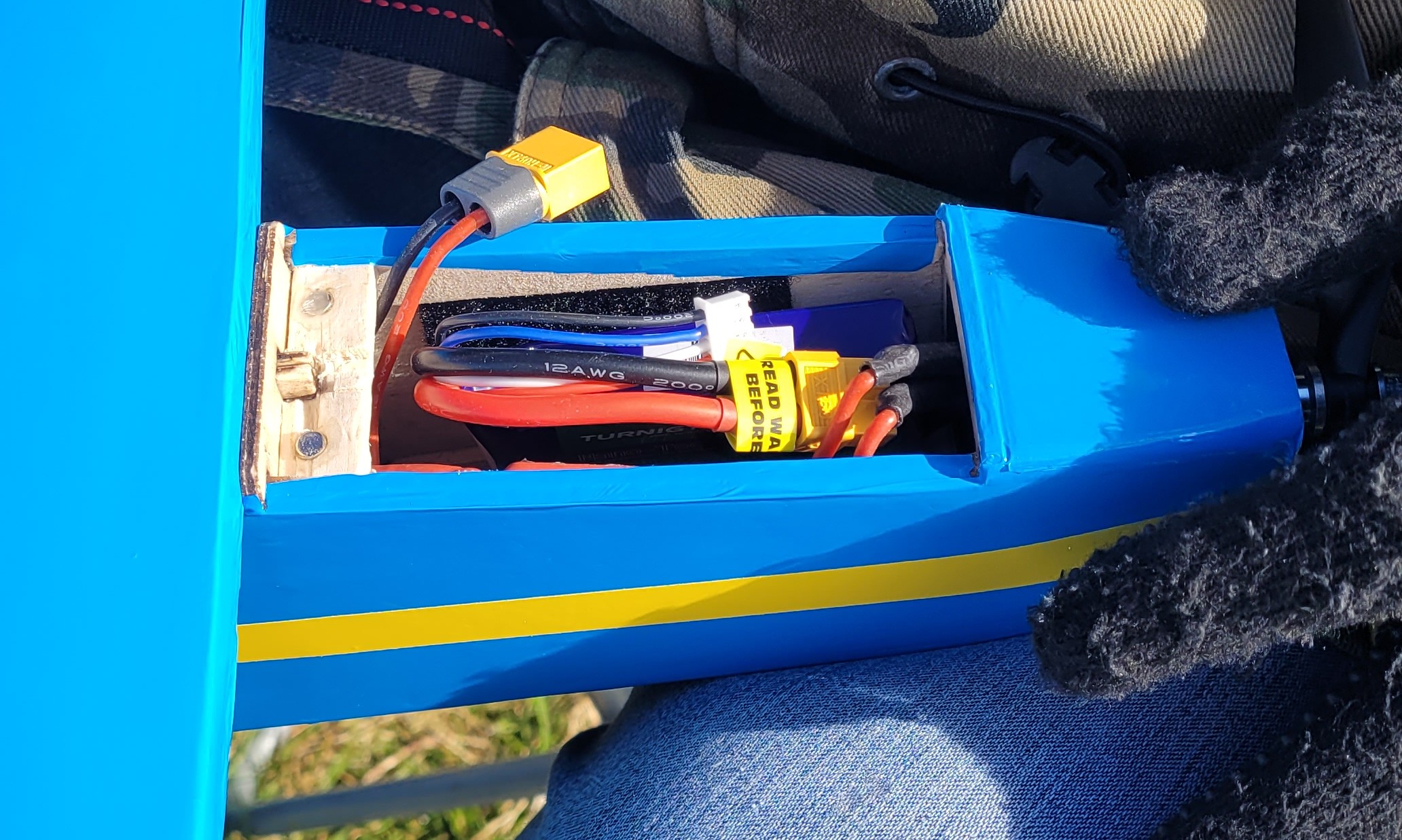
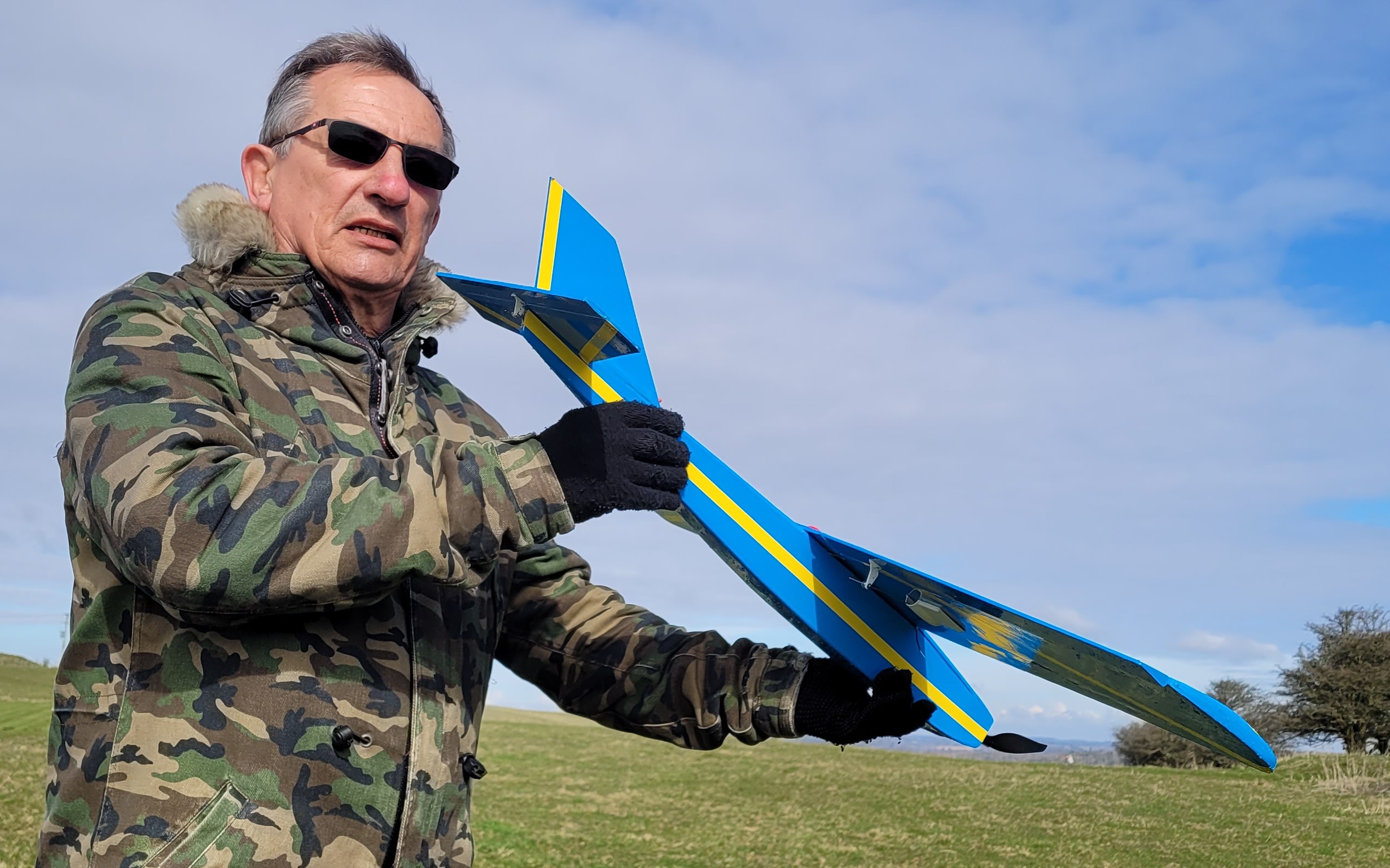
Looking very smart…Bluey not Woody! None of the usual suspects managed to shoot any video of the Bluey flying in March but hopefully I’ll be able to include some next month.
In March I got two models out of semi-retirement and have enjoyed flying them both. First was a Kyosho Raptor that I’d put together back in 2017. Oh look, I haven’t changed a bit…
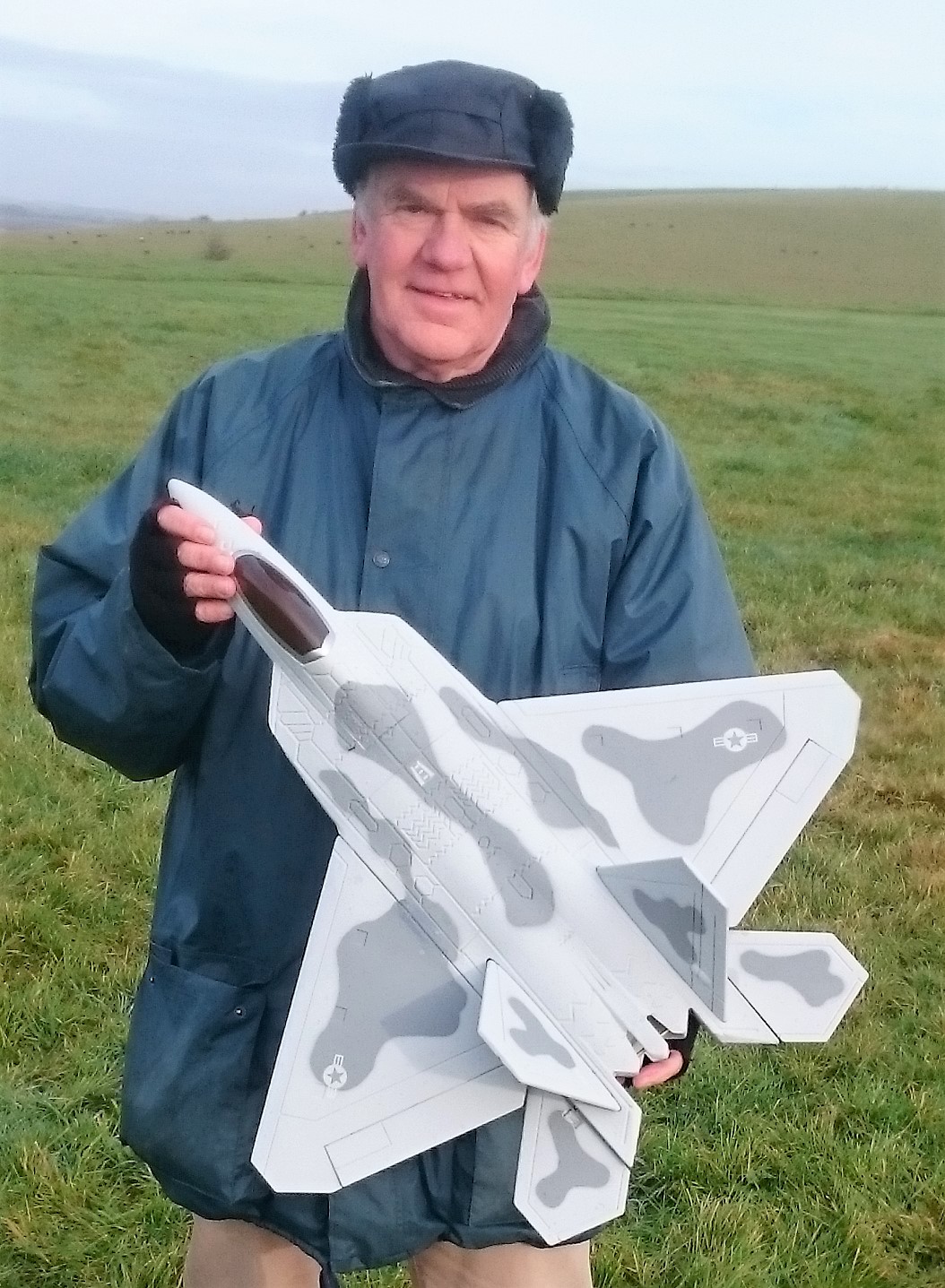 It flew well but one of the aileron servos kept freezing momentarily in flight, fortunately always in the neutral position. Obviously I needed to change the servo but the wiring on the Raptor was all glued in place during the construction to keep the EDF airflow clear.
It flew well but one of the aileron servos kept freezing momentarily in flight, fortunately always in the neutral position. Obviously I needed to change the servo but the wiring on the Raptor was all glued in place during the construction to keep the EDF airflow clear.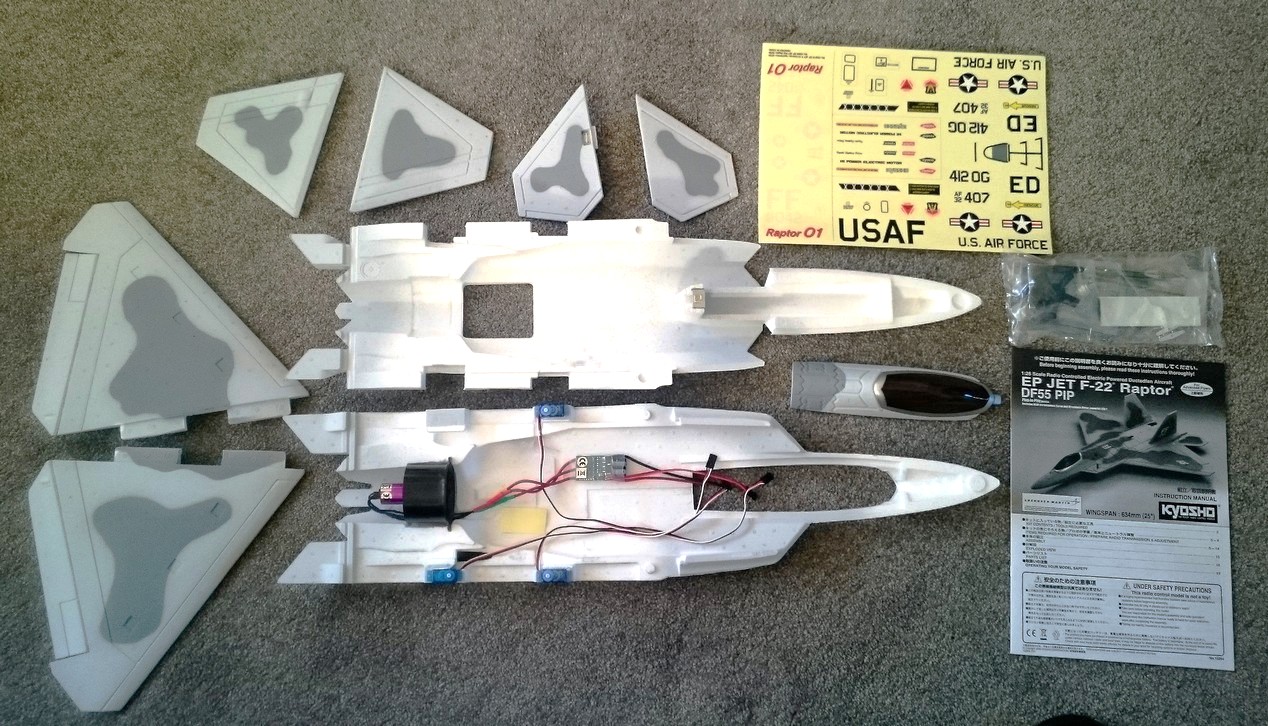
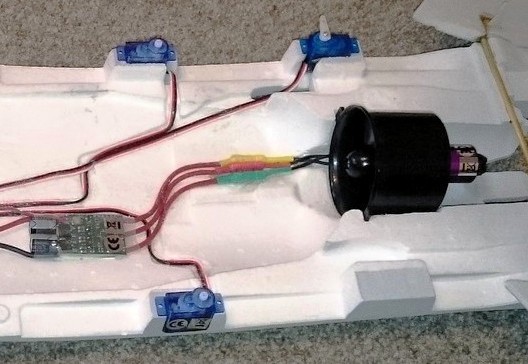 So I stopped flying it while I pondered…for several years! I decided the only thing to do was to cut the servo off, leaving the wire glued in place, and then run the new servo wire through the duct as neatly as possible. Once I’d bitten the bullet if was very easily done, something I should have sorted years ago! The other change I made was to enlarge the battery bay slightly so I could use 2200mAh 3 cell packs instead of the 1300mAh packs.
So I stopped flying it while I pondered…for several years! I decided the only thing to do was to cut the servo off, leaving the wire glued in place, and then run the new servo wire through the duct as neatly as possible. Once I’d bitten the bullet if was very easily done, something I should have sorted years ago! The other change I made was to enlarge the battery bay slightly so I could use 2200mAh 3 cell packs instead of the 1300mAh packs.
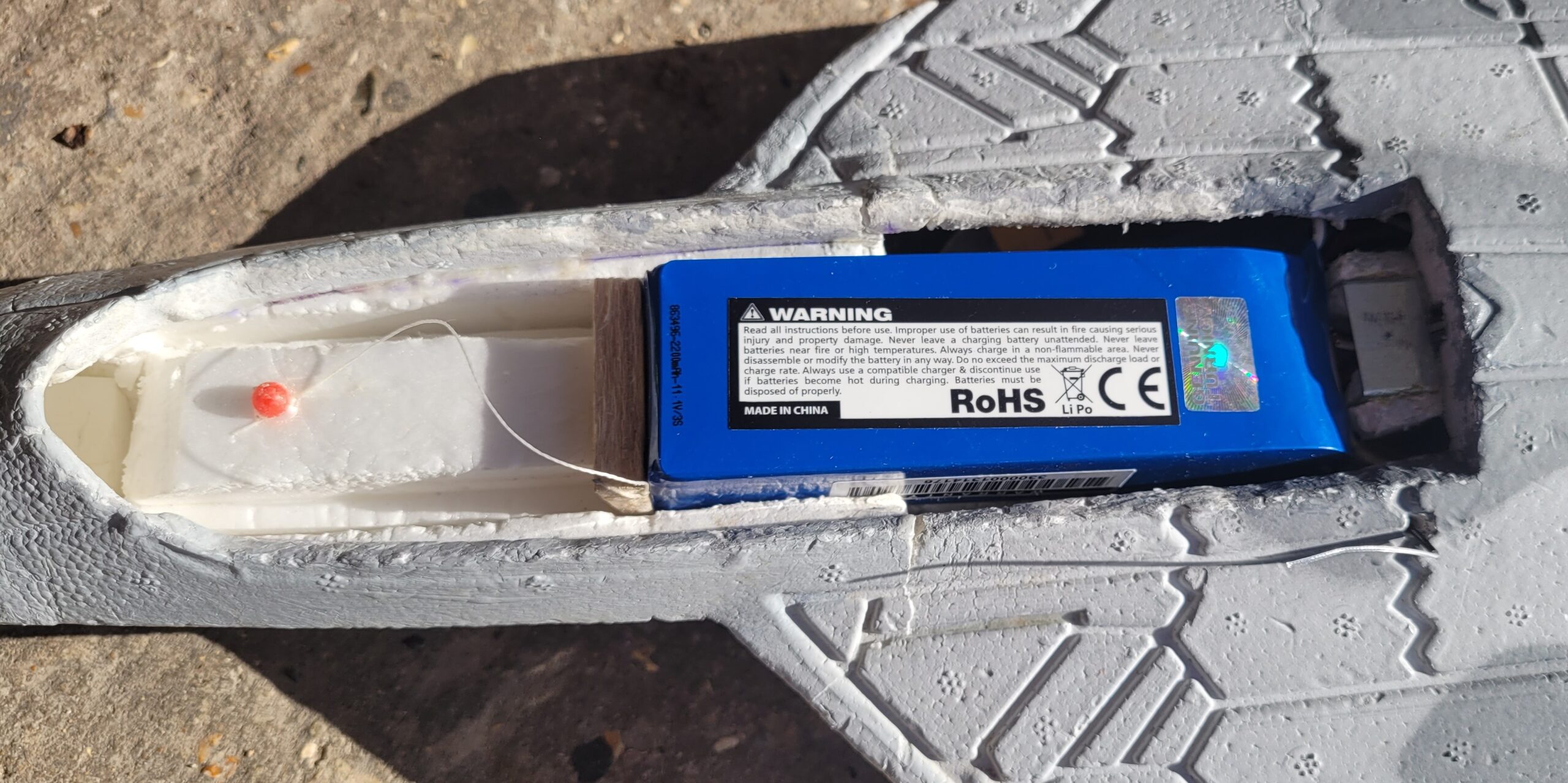 This meant adding even more lead to the tail to correct the centre of gravity so, with the extra battery weight and the lead, the Raptor is now considerably heavier than intended. It needs a bit more of a chuck to get it away from the launch but once airborne it is nice and smooth to fly and I get around five minutes airtime. It’s in the video, I think it looks good.
This meant adding even more lead to the tail to correct the centre of gravity so, with the extra battery weight and the lead, the Raptor is now considerably heavier than intended. It needs a bit more of a chuck to get it away from the launch but once airborne it is nice and smooth to fly and I get around five minutes airtime. It’s in the video, I think it looks good.
The other rejuvenated model is my little Sharkface, another model that I had built in 2017.
 The original was a single channel (rudder only) model designed in 1965 by Eric Clutton and in those days many people fitted them with Cox .049 glow-plug engines, although the design says for up to 1.5cc so some modellers fitted one of the small diesel engines that were popular in the sixties. In March 2017 RCM&E re-issued the original plan along with an article by Shaun Garrity and also added a Mk2 version of the plan which updated it for modern radio by adding an elevator. I’d stopped flying mine because I’d damaged the old ‘bell’ type motor it was fitted with and although it still ran there was a terrible vibration.
The original was a single channel (rudder only) model designed in 1965 by Eric Clutton and in those days many people fitted them with Cox .049 glow-plug engines, although the design says for up to 1.5cc so some modellers fitted one of the small diesel engines that were popular in the sixties. In March 2017 RCM&E re-issued the original plan along with an article by Shaun Garrity and also added a Mk2 version of the plan which updated it for modern radio by adding an elevator. I’d stopped flying mine because I’d damaged the old ‘bell’ type motor it was fitted with and although it still ran there was a terrible vibration.
This month I rummaged through my stuff for the smallest motor I could find but the best I had was a drone motor from an old foamboard model. It was soon fitted along with a 30A speed controller and, as the old bell motor only used a 10A controller, I knew there was going to be huge increase in power! I fitted the smallest prop I could find, a 5×4, and gave it a go. The first couple of flights were ‘interesting.’ I’ve found that it needs to be launched at less than half throttle and, having reduced the rates a lot, it flies well… mad but well!
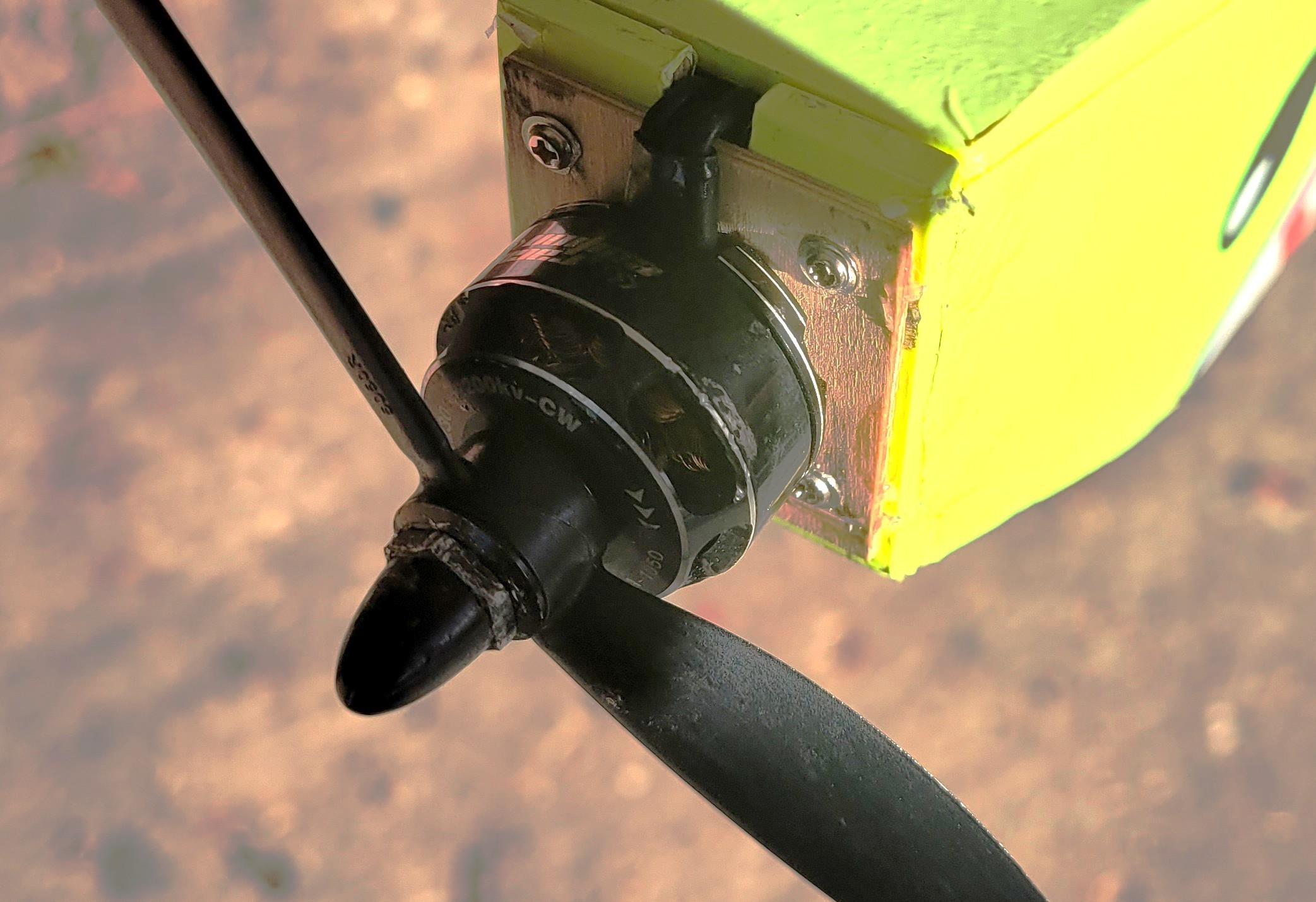 Note how much the covering has faded over the eight years since I built it. I was very lucky with one landing which finished right on the spot, total fluke, I wasn’t even aiming for it!
Note how much the covering has faded over the eight years since I built it. I was very lucky with one landing which finished right on the spot, total fluke, I wasn’t even aiming for it!
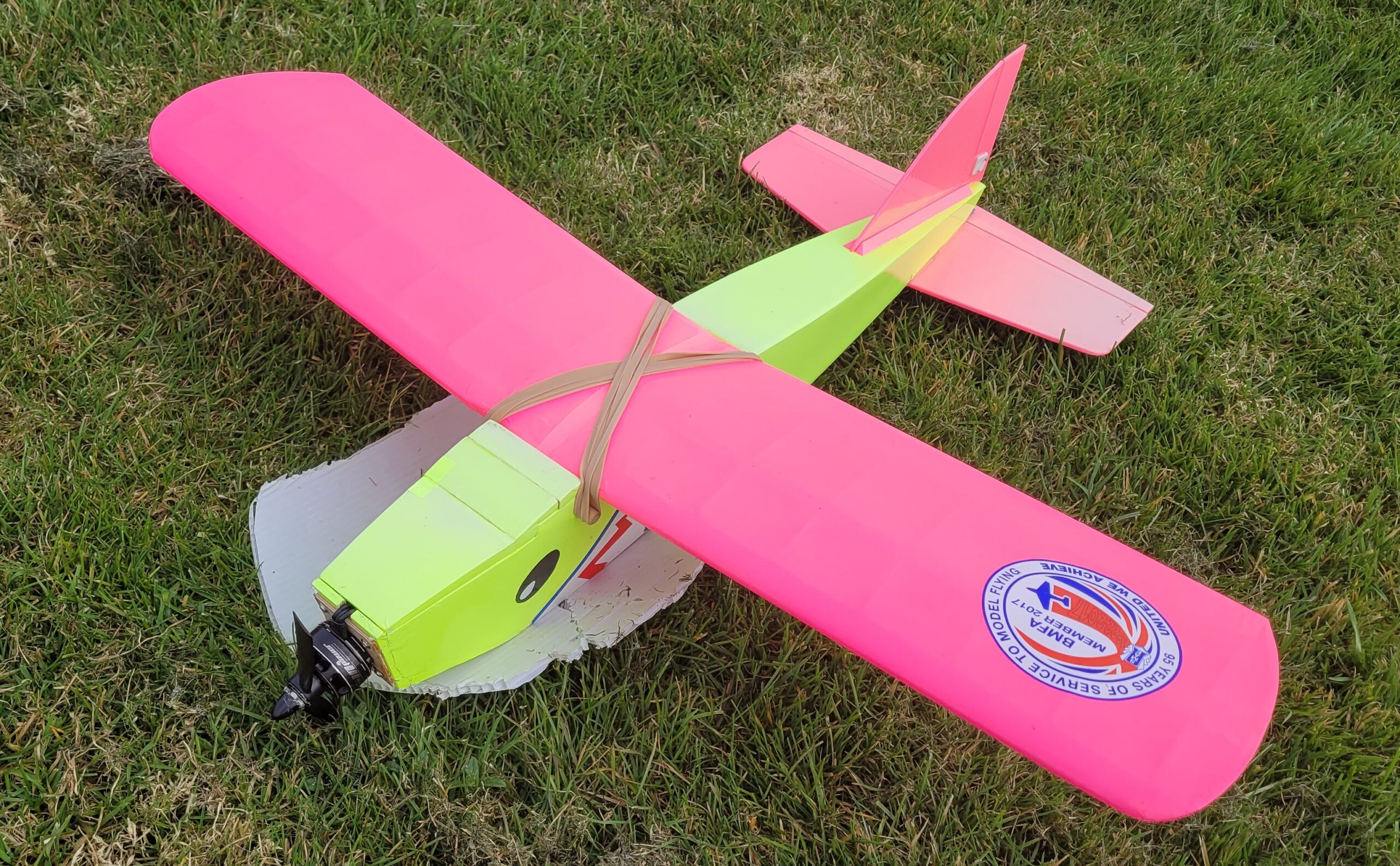 You can see the Sharkface in action in the video, it’s ridiculously overpowered but fun.
You can see the Sharkface in action in the video, it’s ridiculously overpowered but fun.
The action shots this month are all taken from the video so rather poor quality I’m afraid: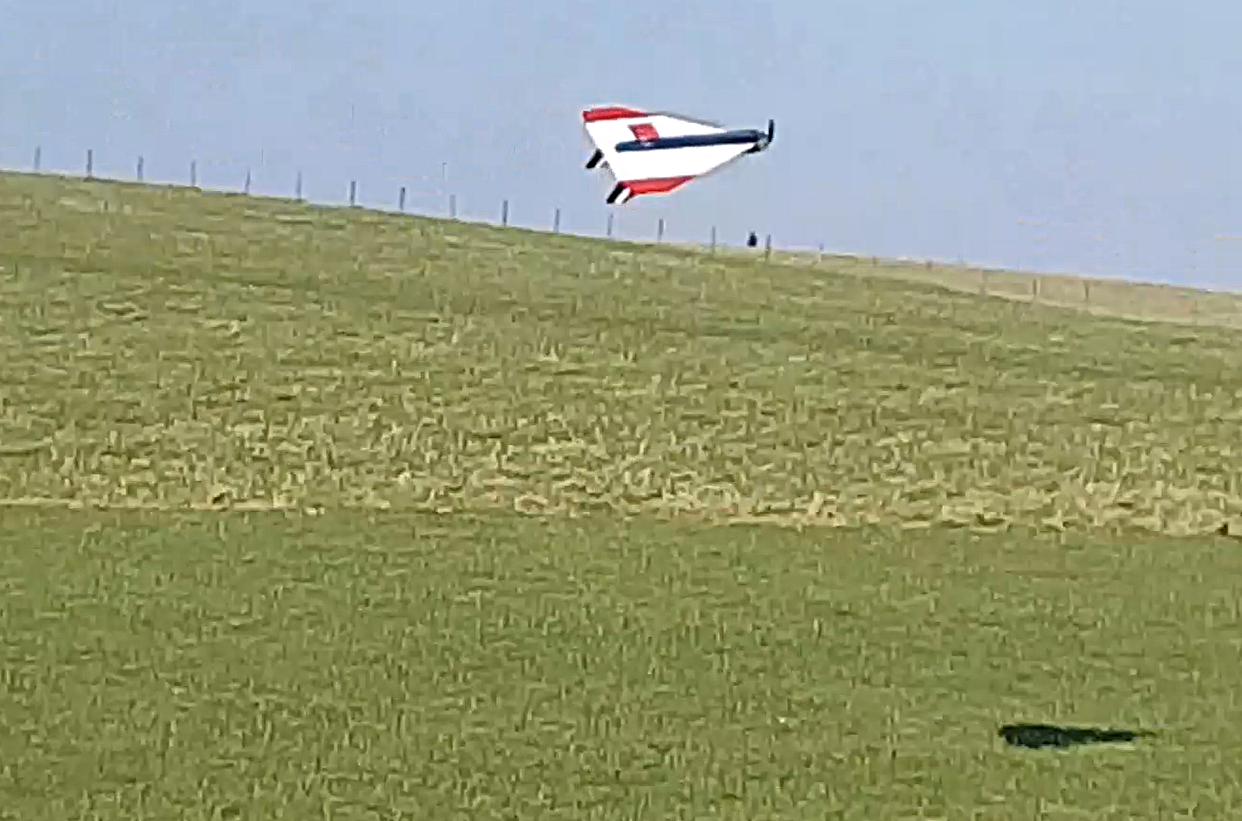
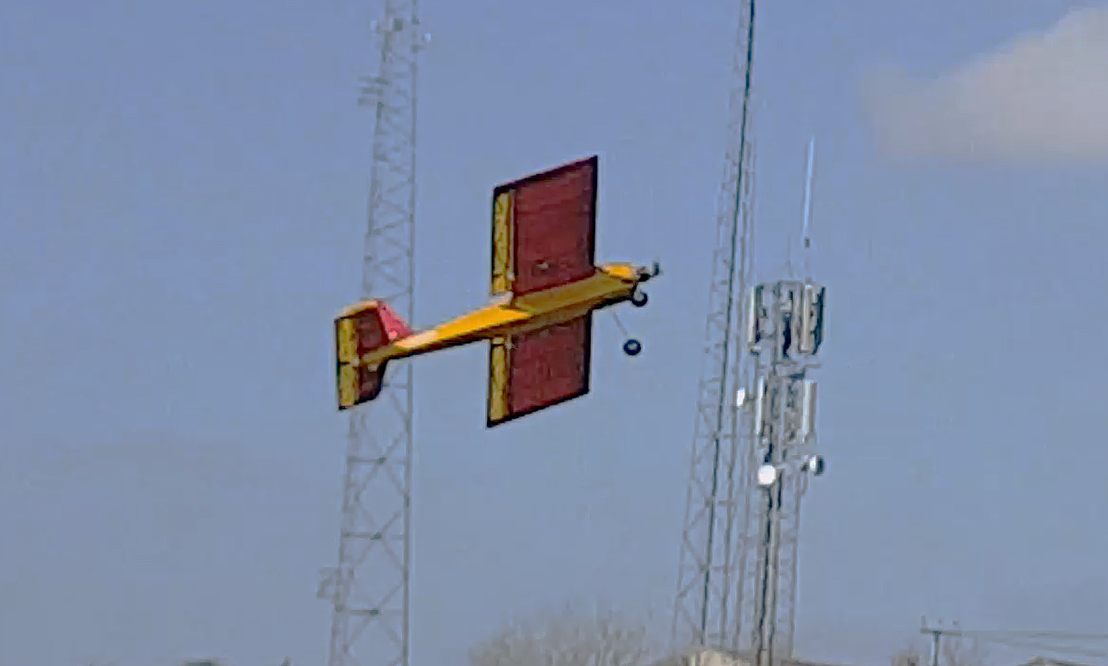
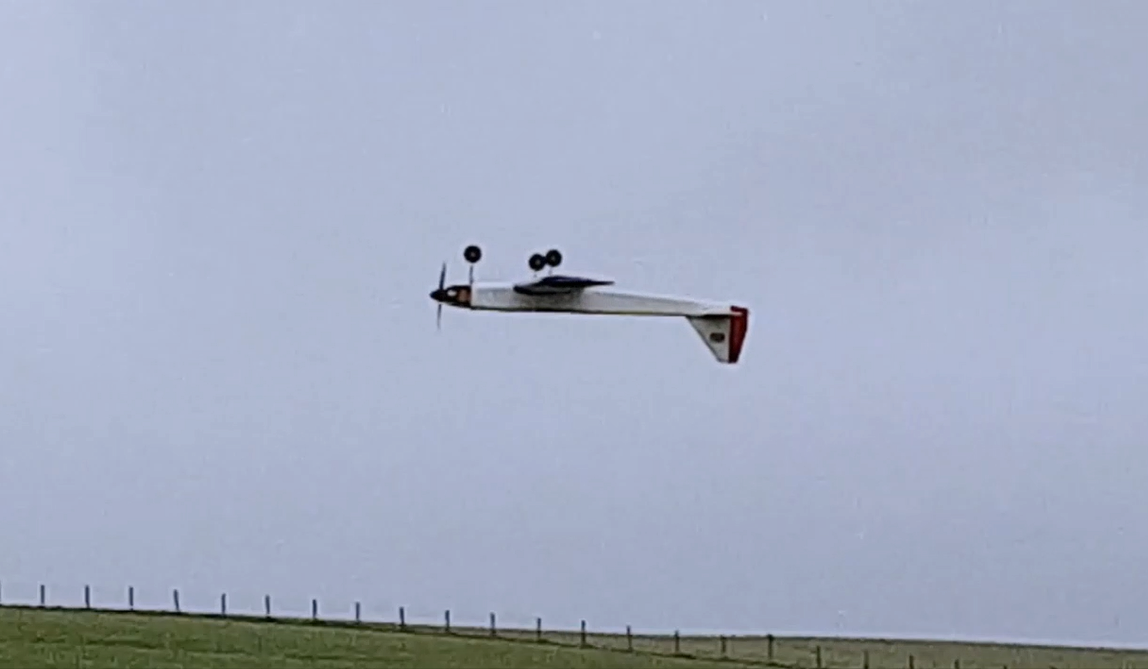
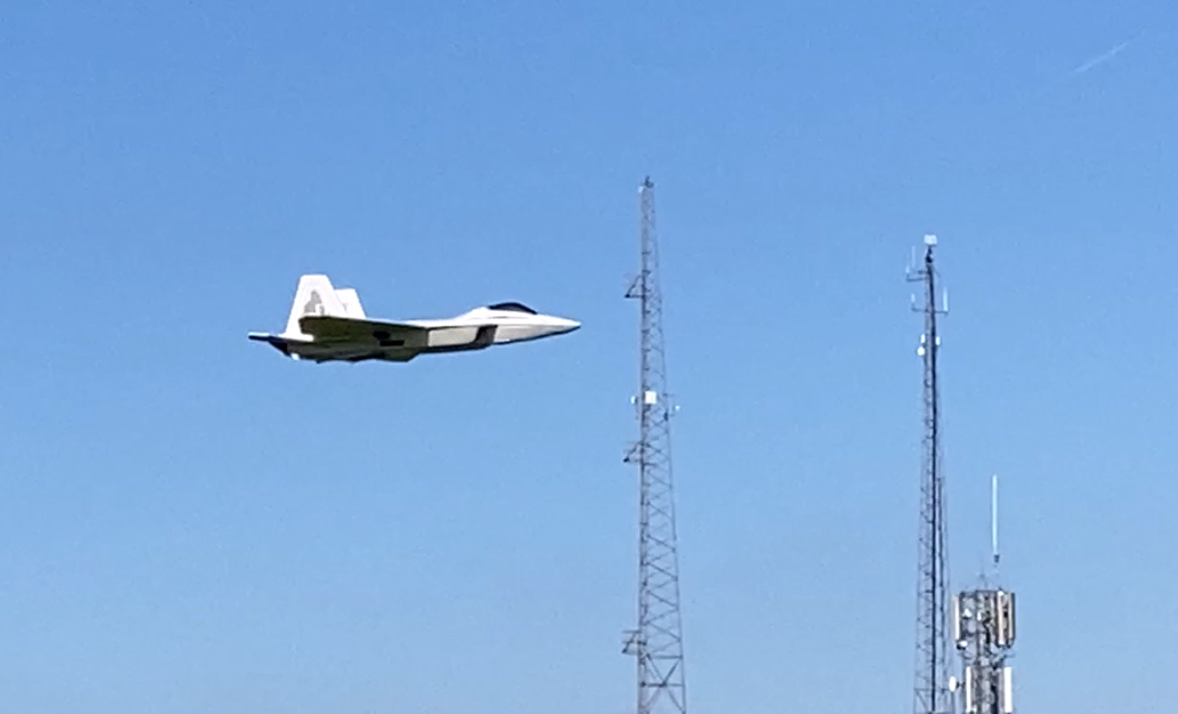
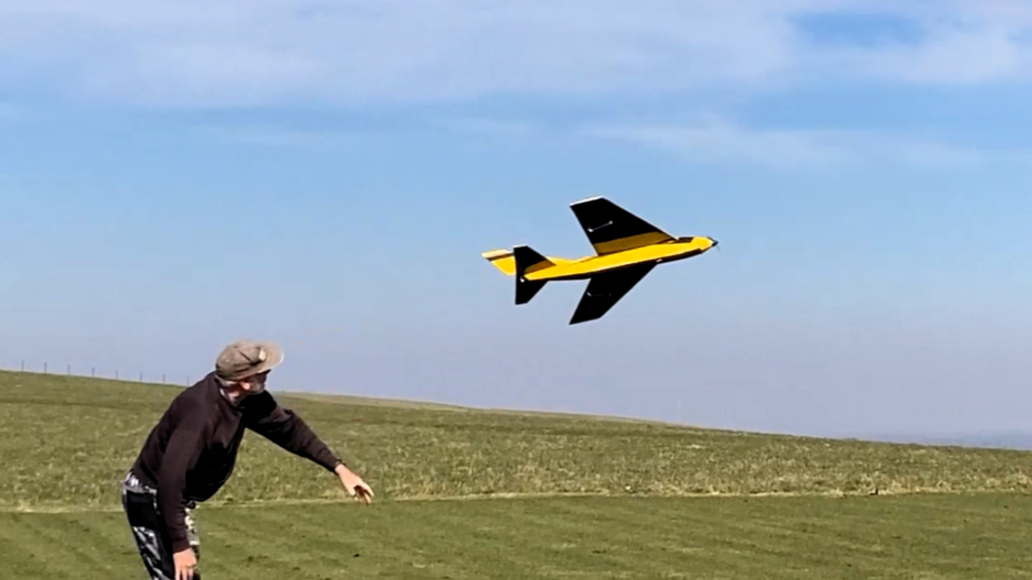
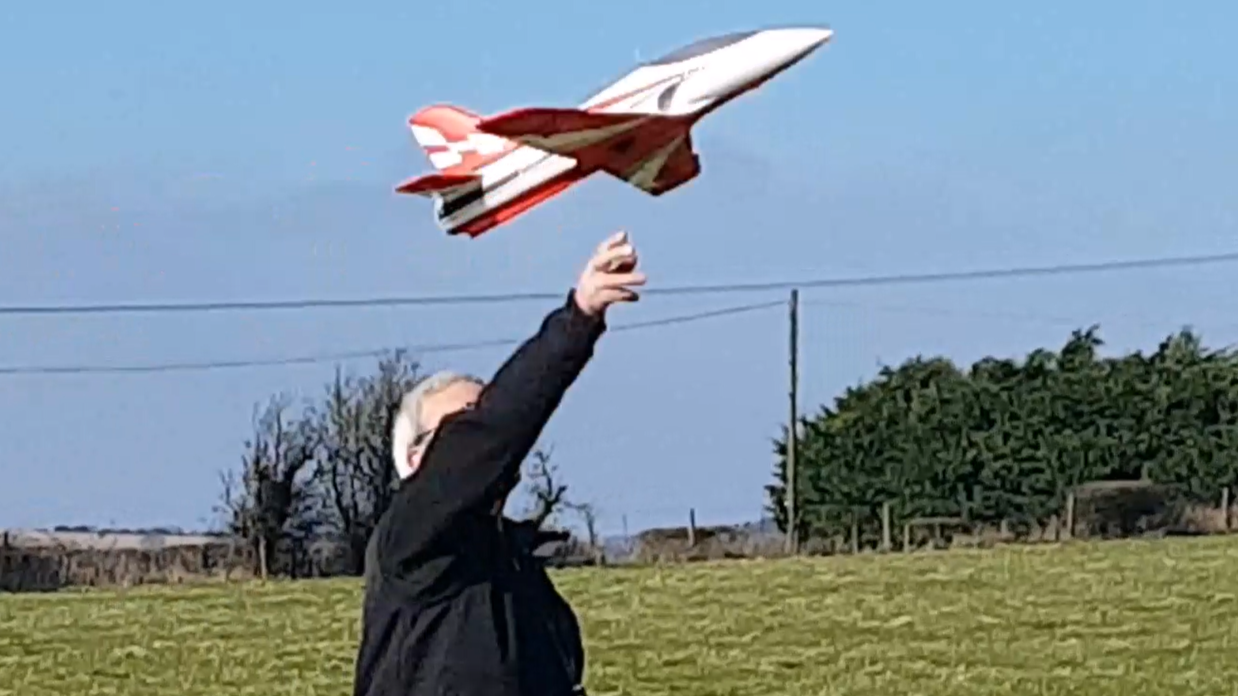
Video time now, this month with footage shot by myself, Dougal Entendre, and MacFly.
Please watch the video full-screen, it’s so much better with small models flying around:
If the video won’t play for you please click HERE
The Final Funny:
This month I have a helpful tip for you when you’re flying off on your holiday.
If you board the plane and spot Jack, your old mate from school, don’t call out “Hi Jack!”
Colin Cowplain


Great work as always Colin. One of the photos really does highlight why it’s so important everyone sticks to an agreed circuit, it’s not such a foolish rule as many think.
Thanks Colin. Patch news is something to look forward to at the start of the month.